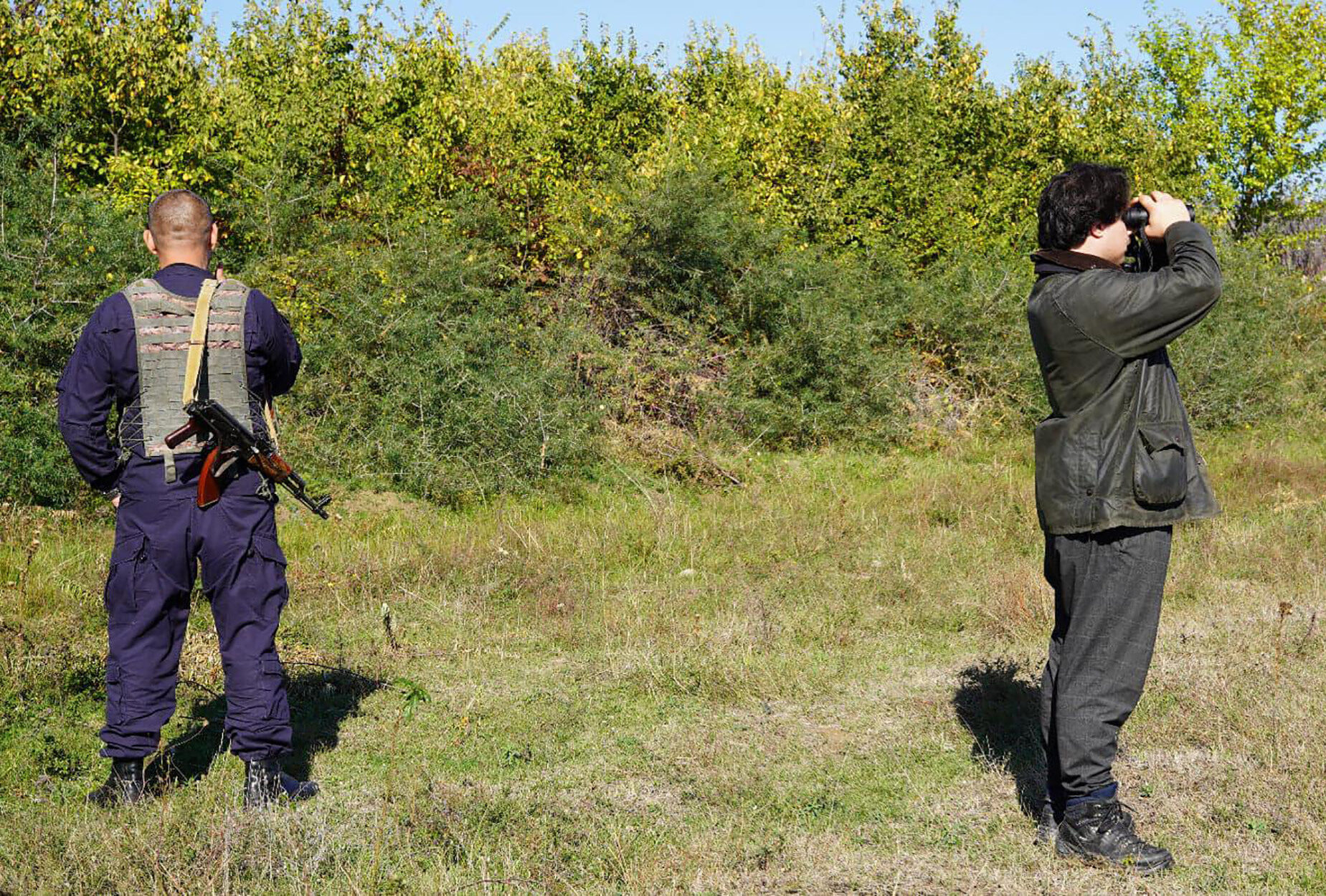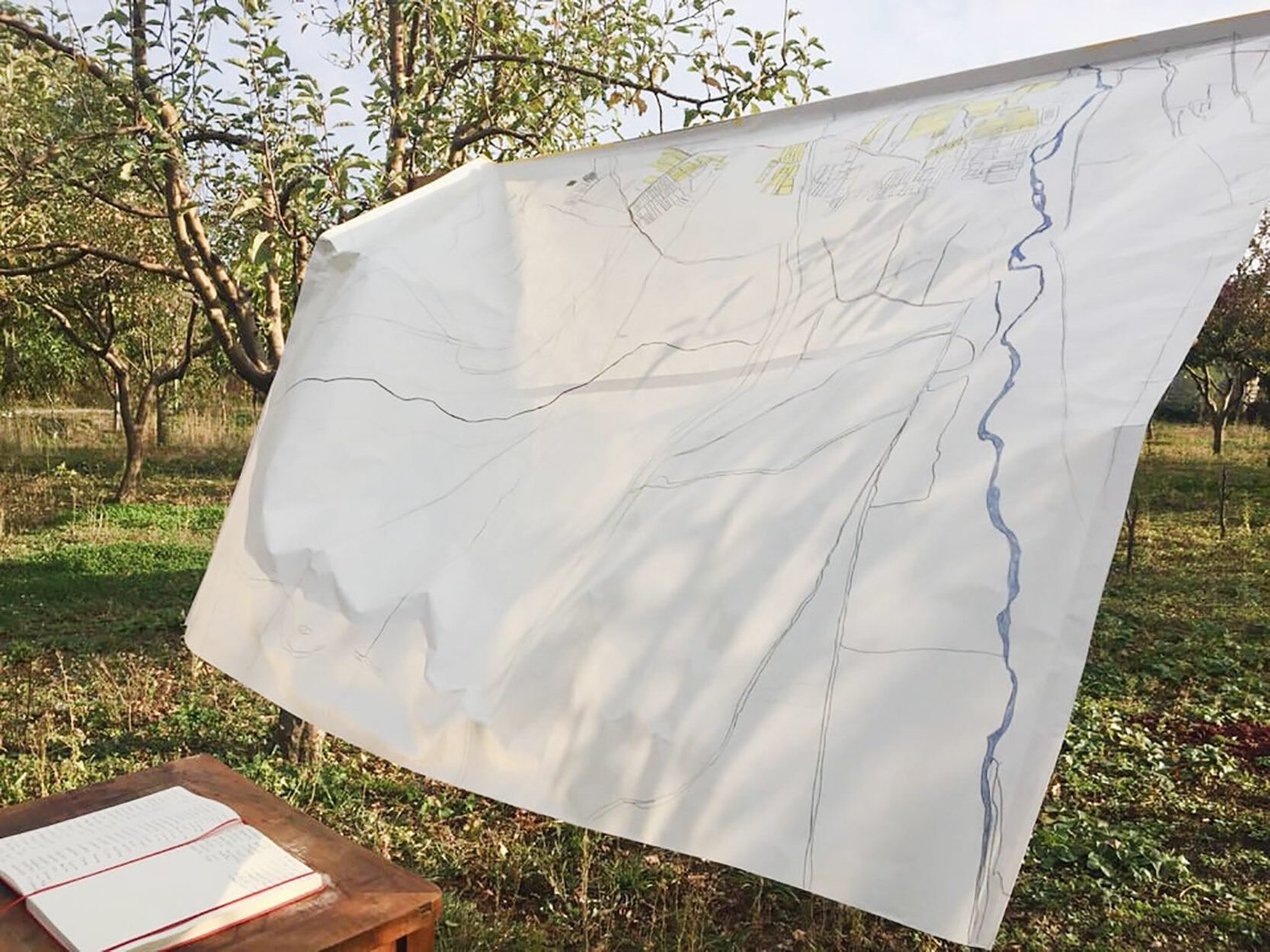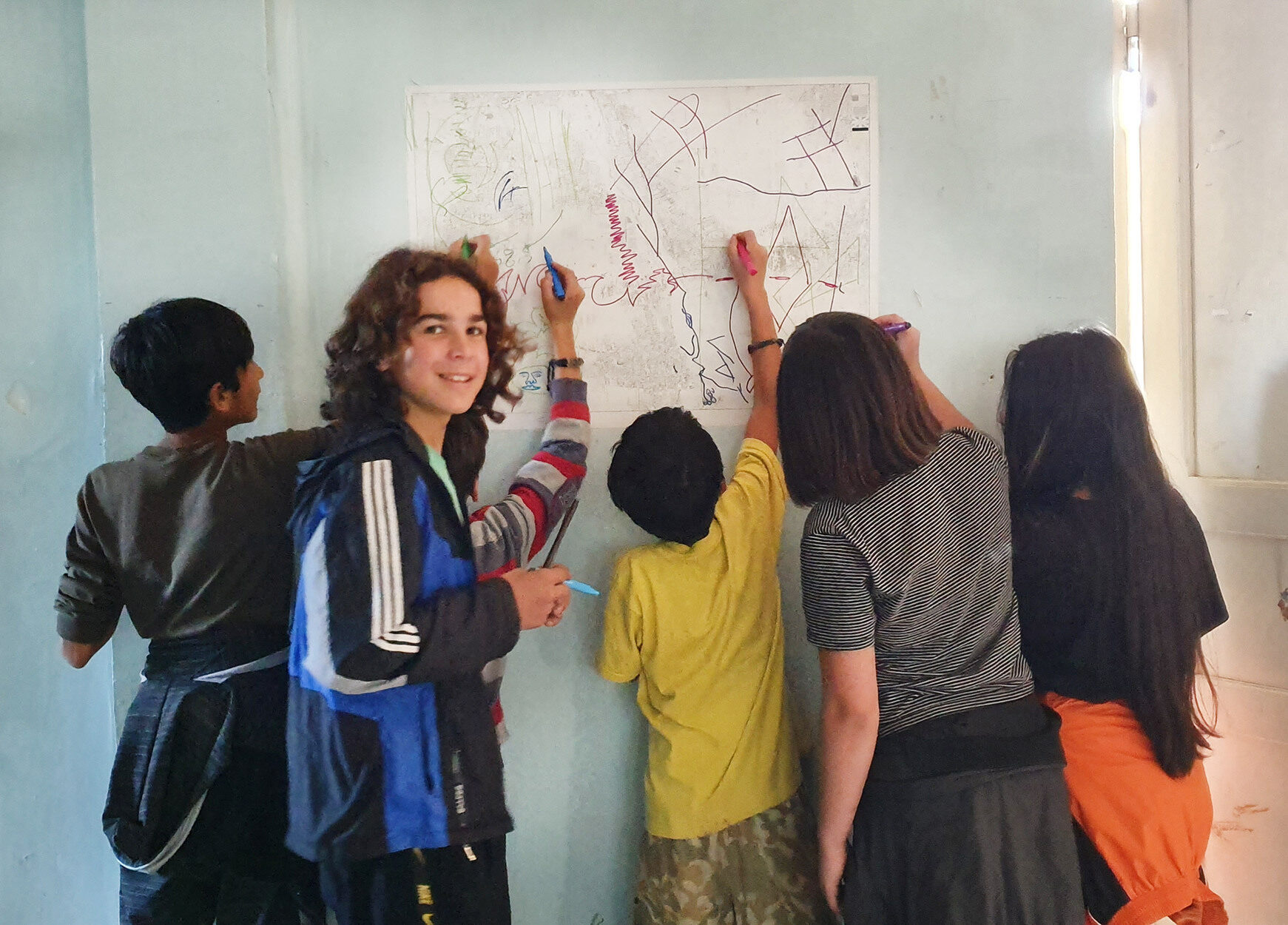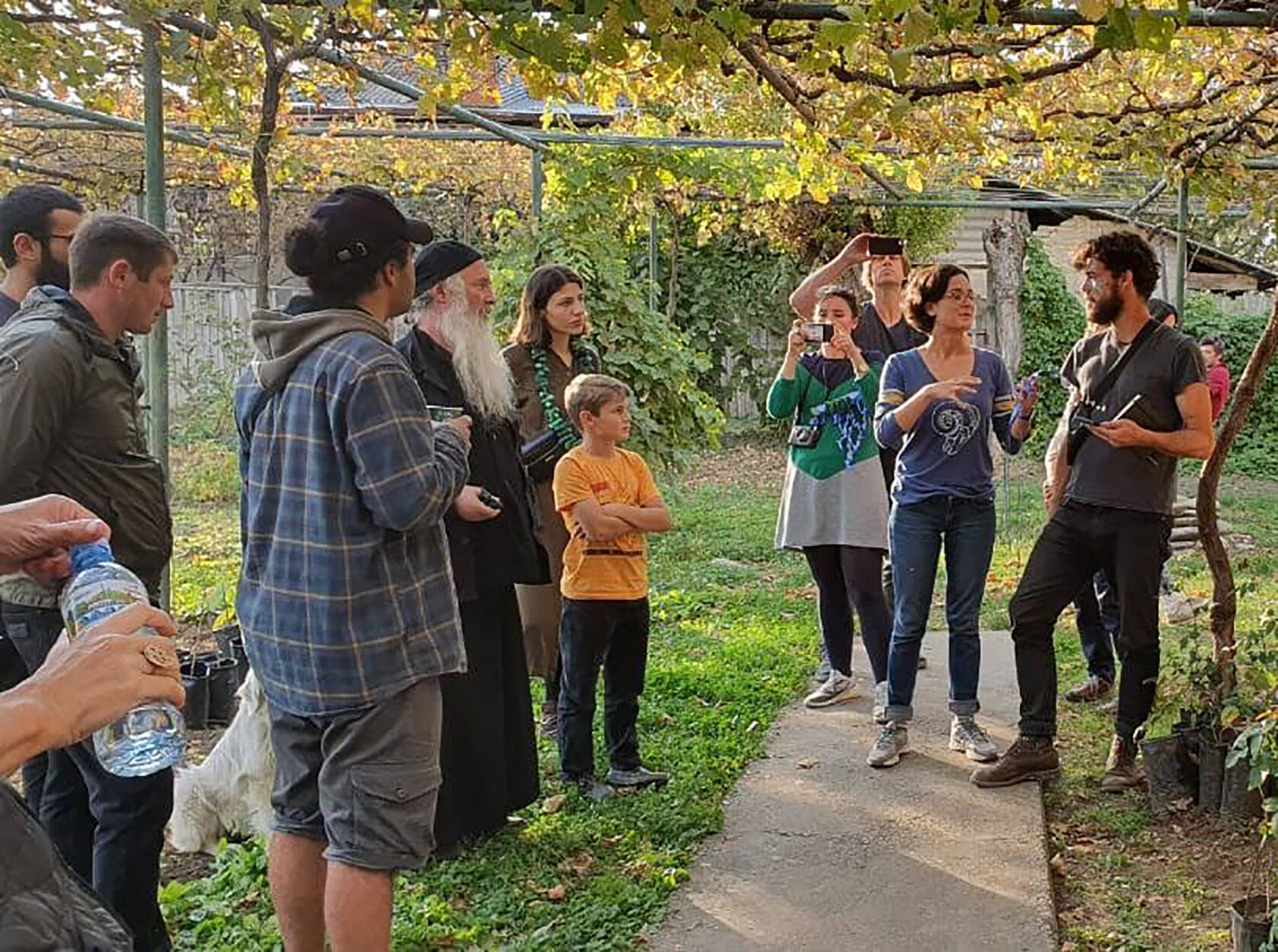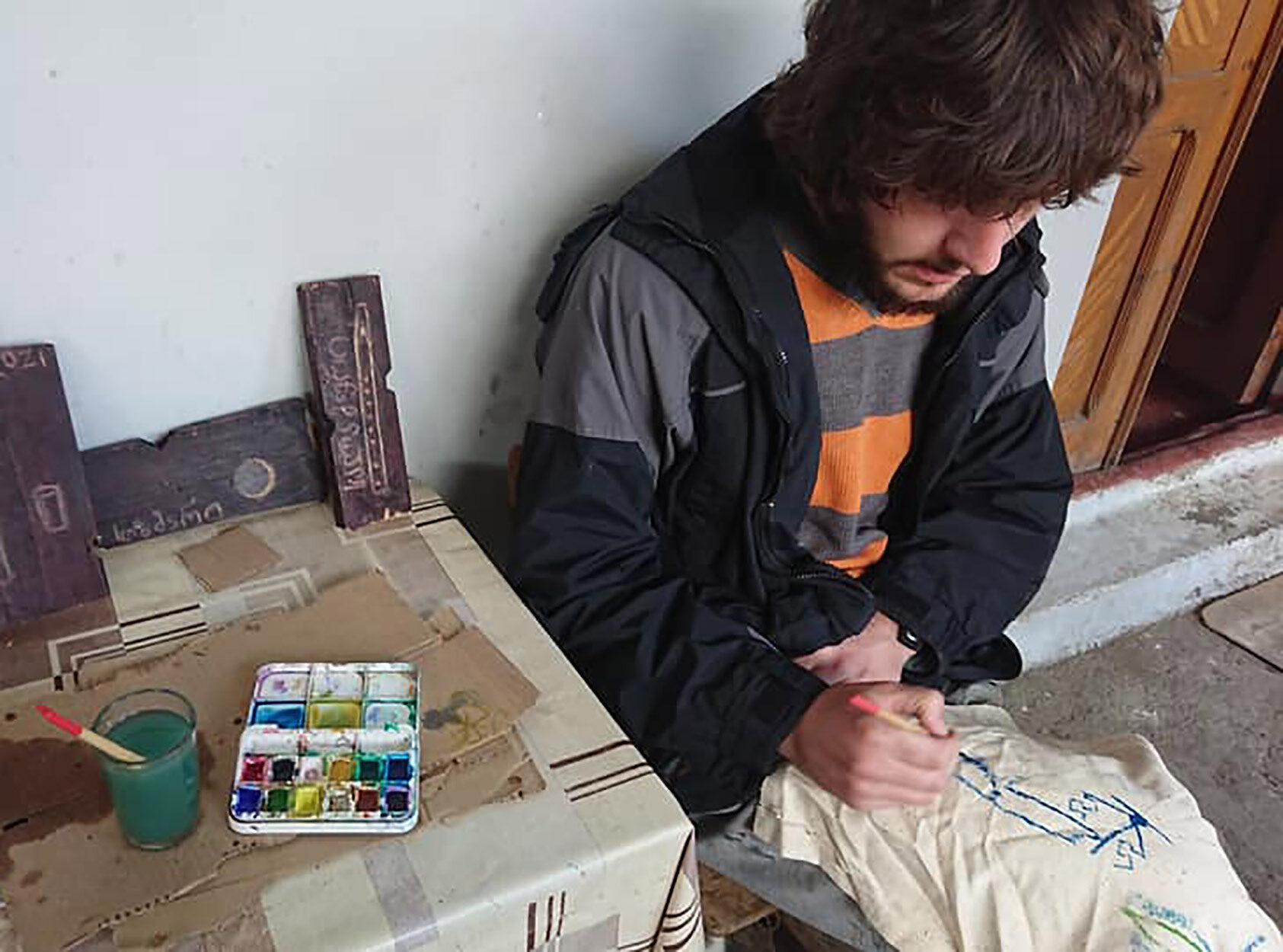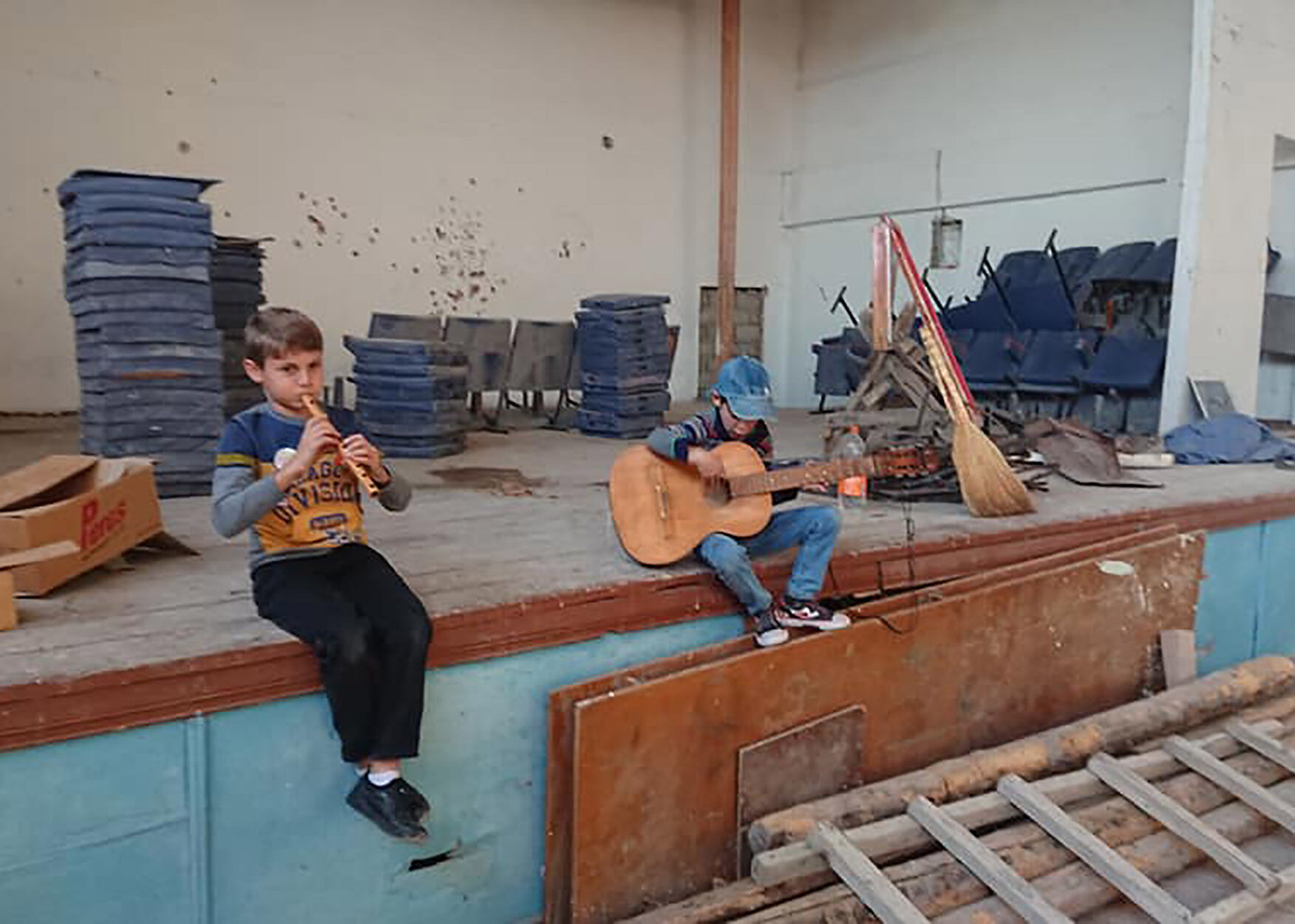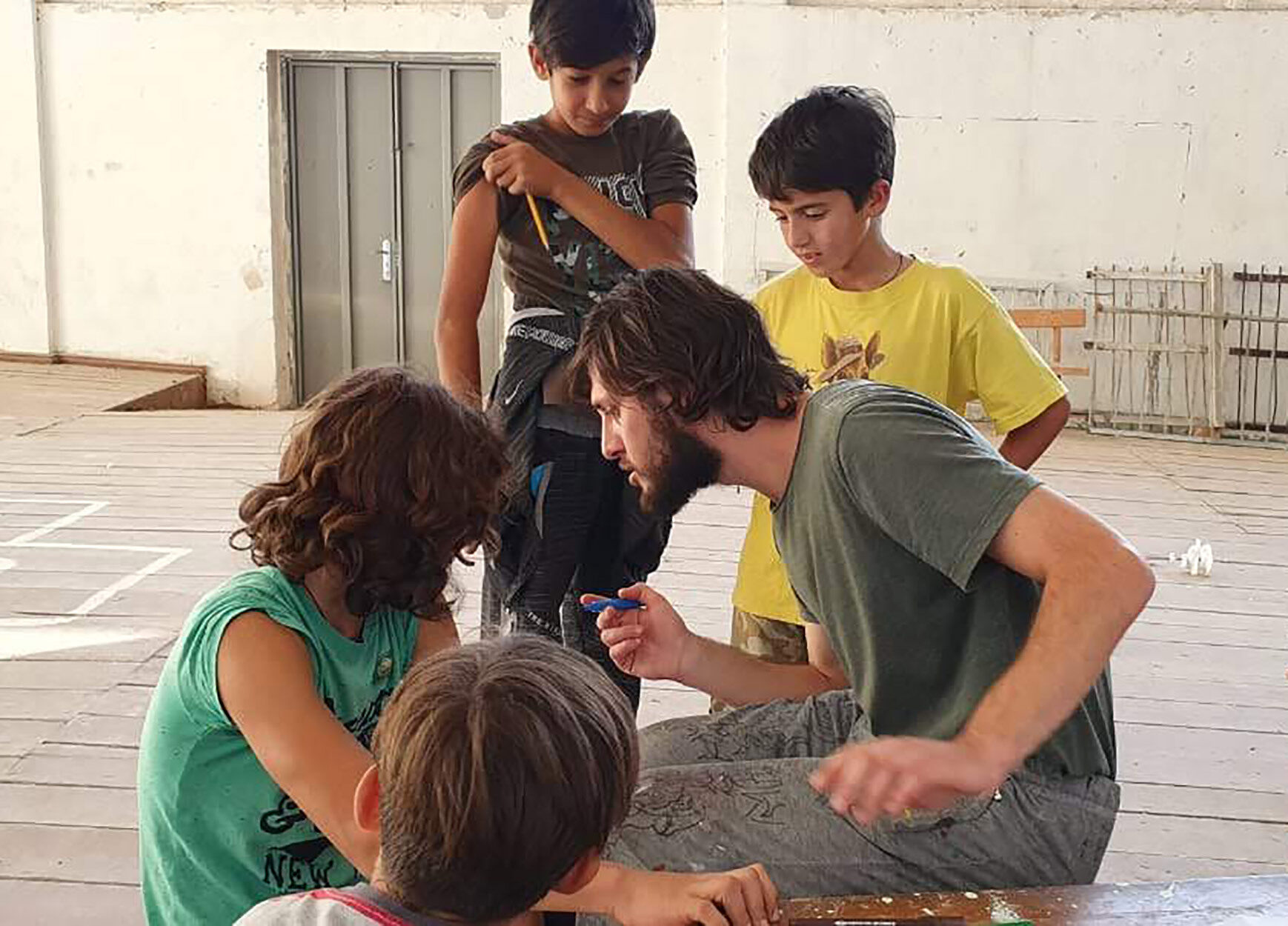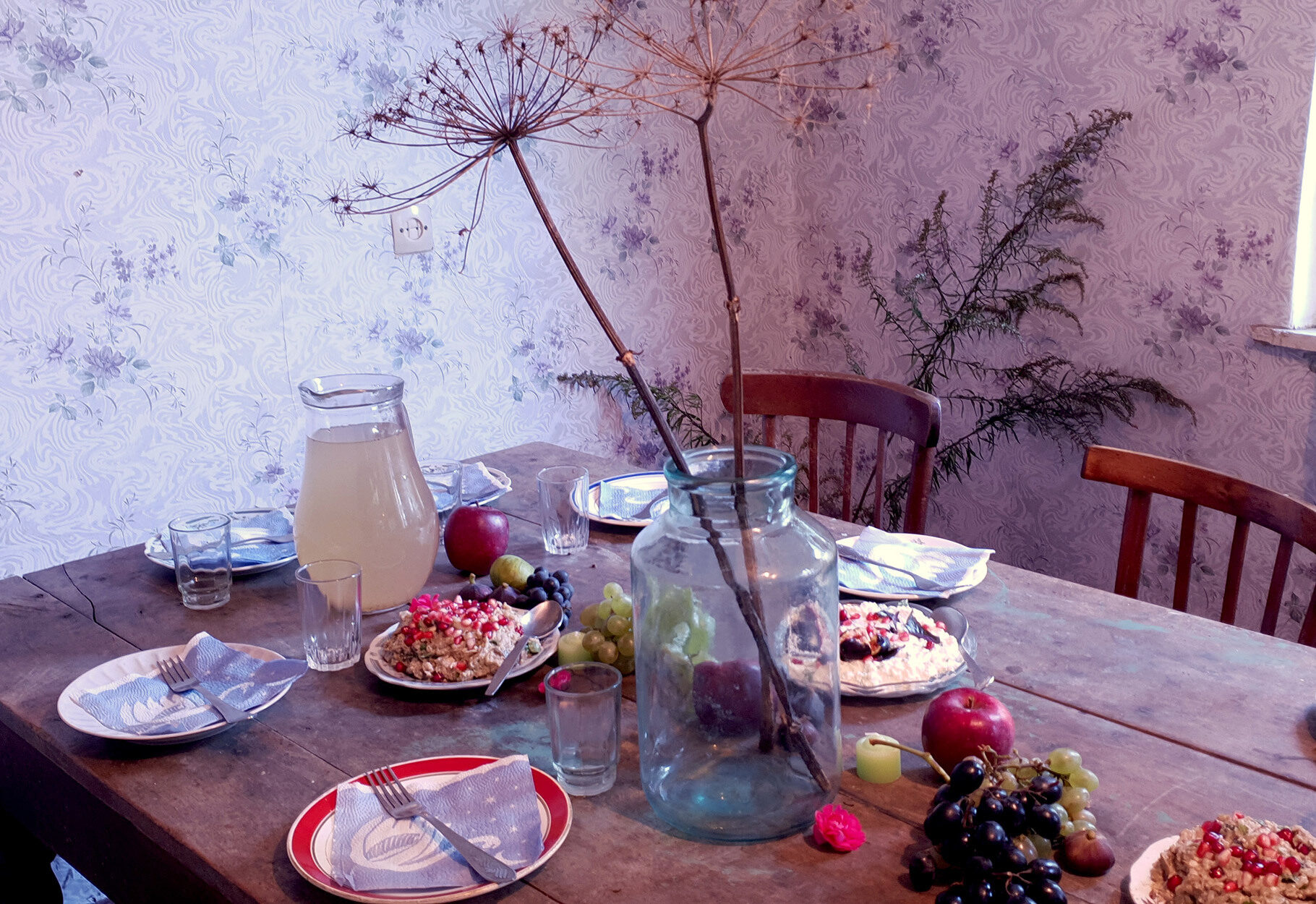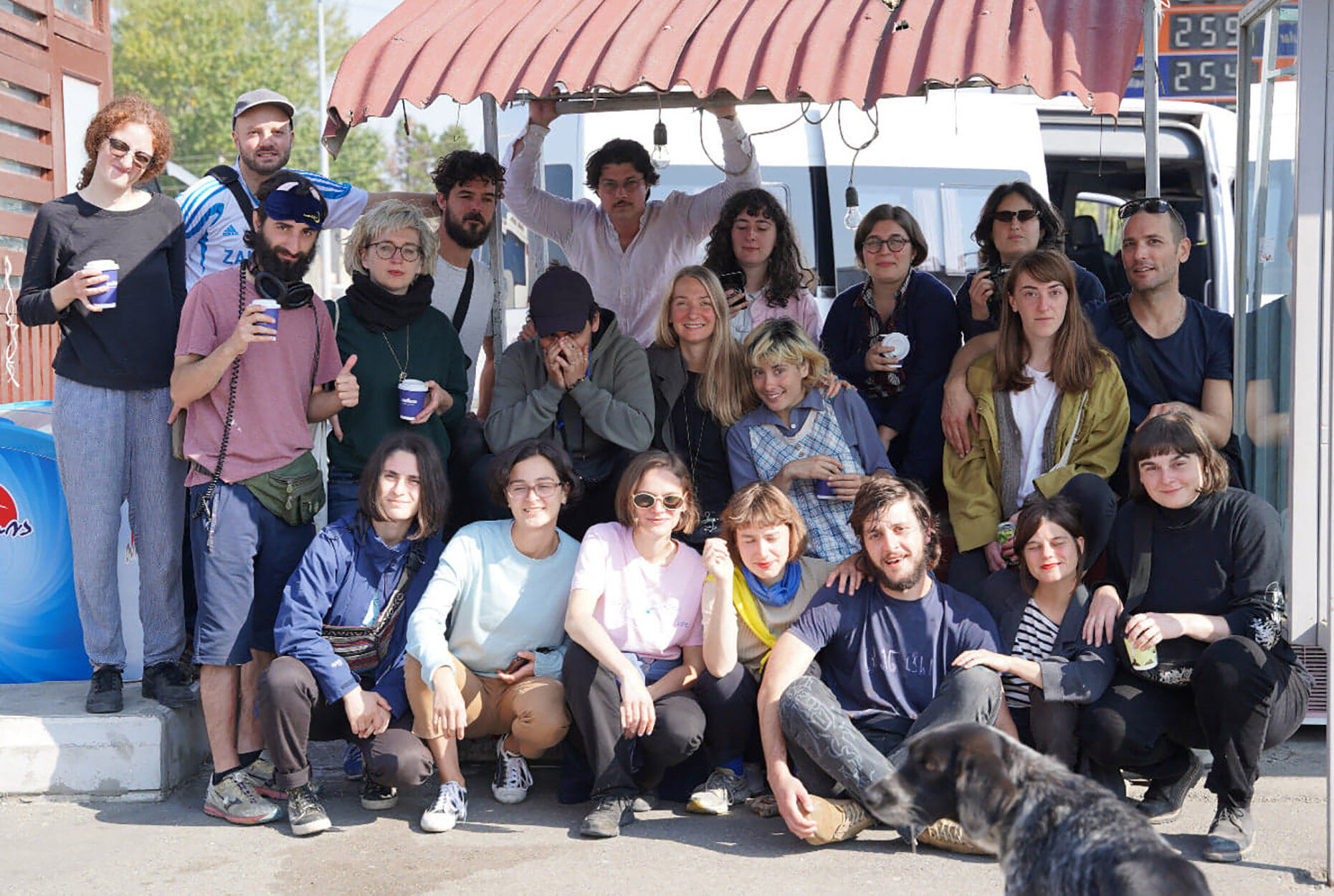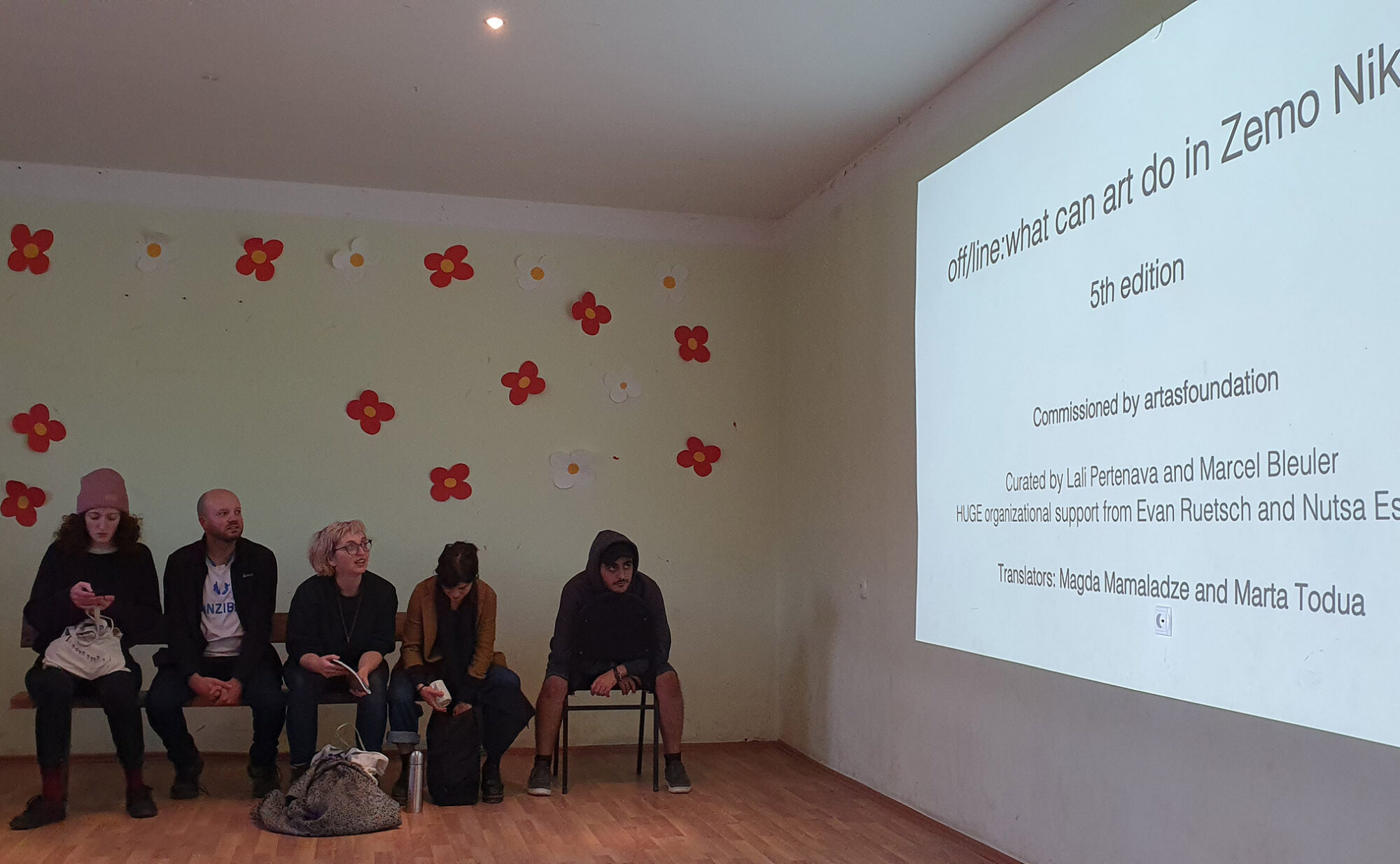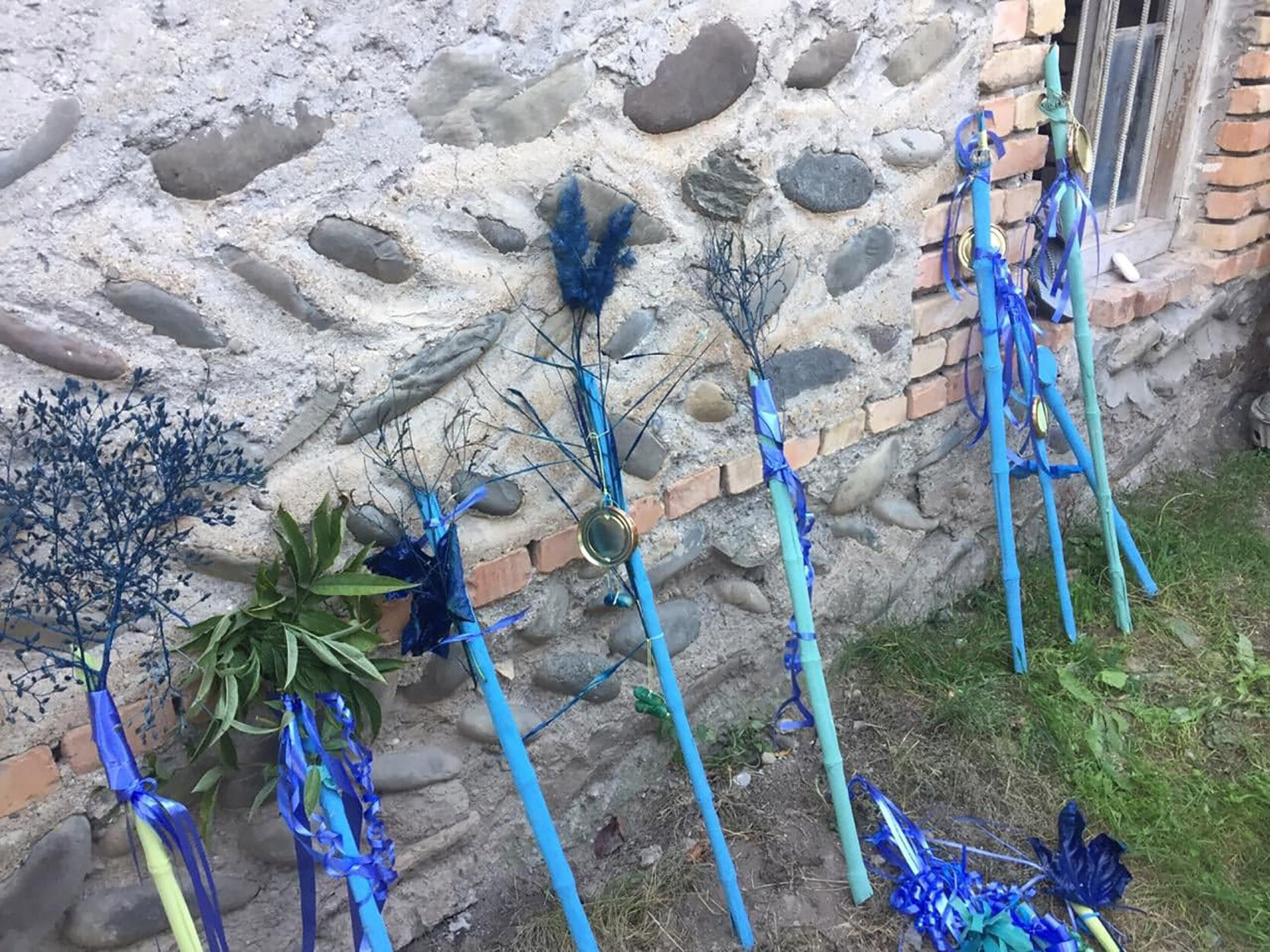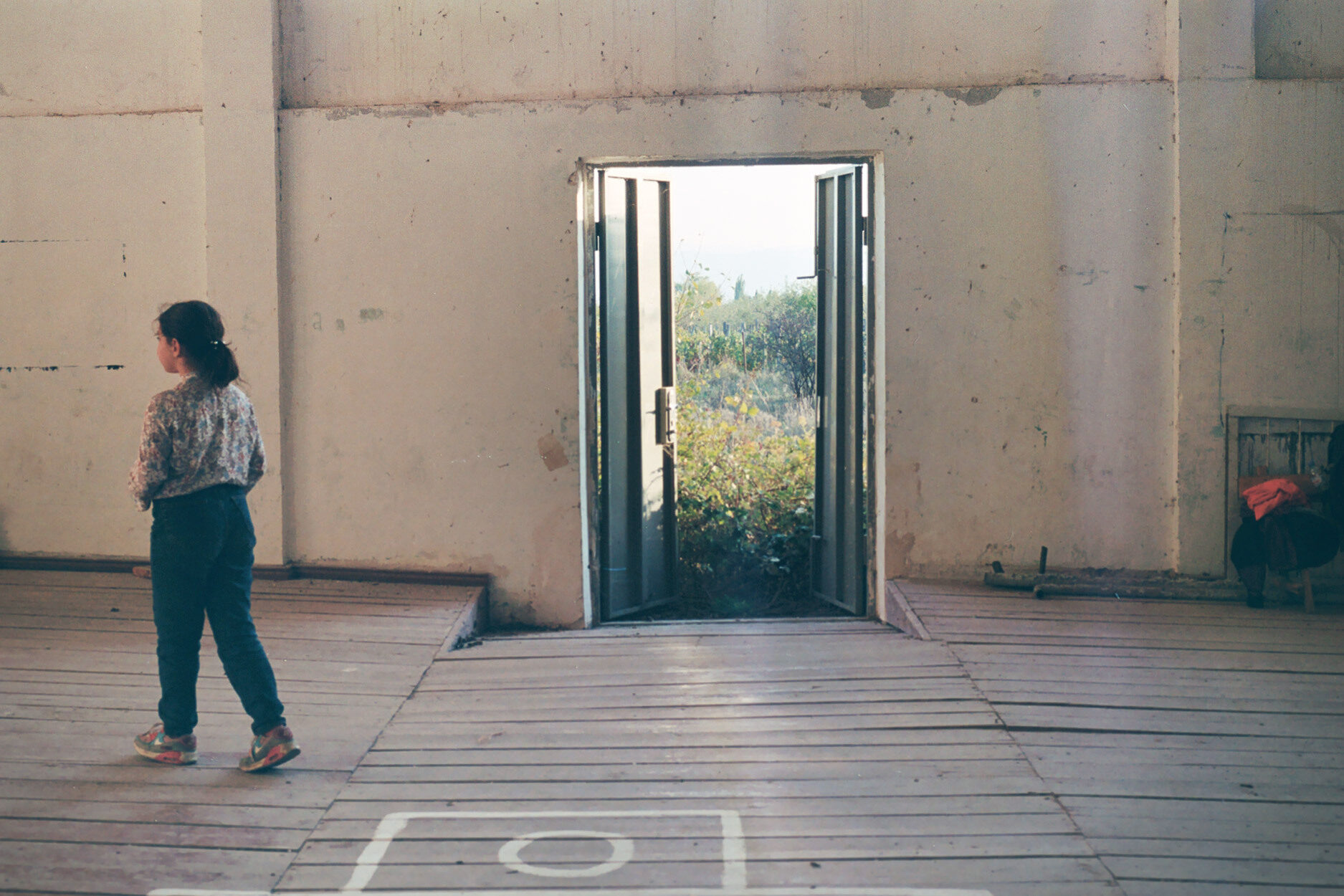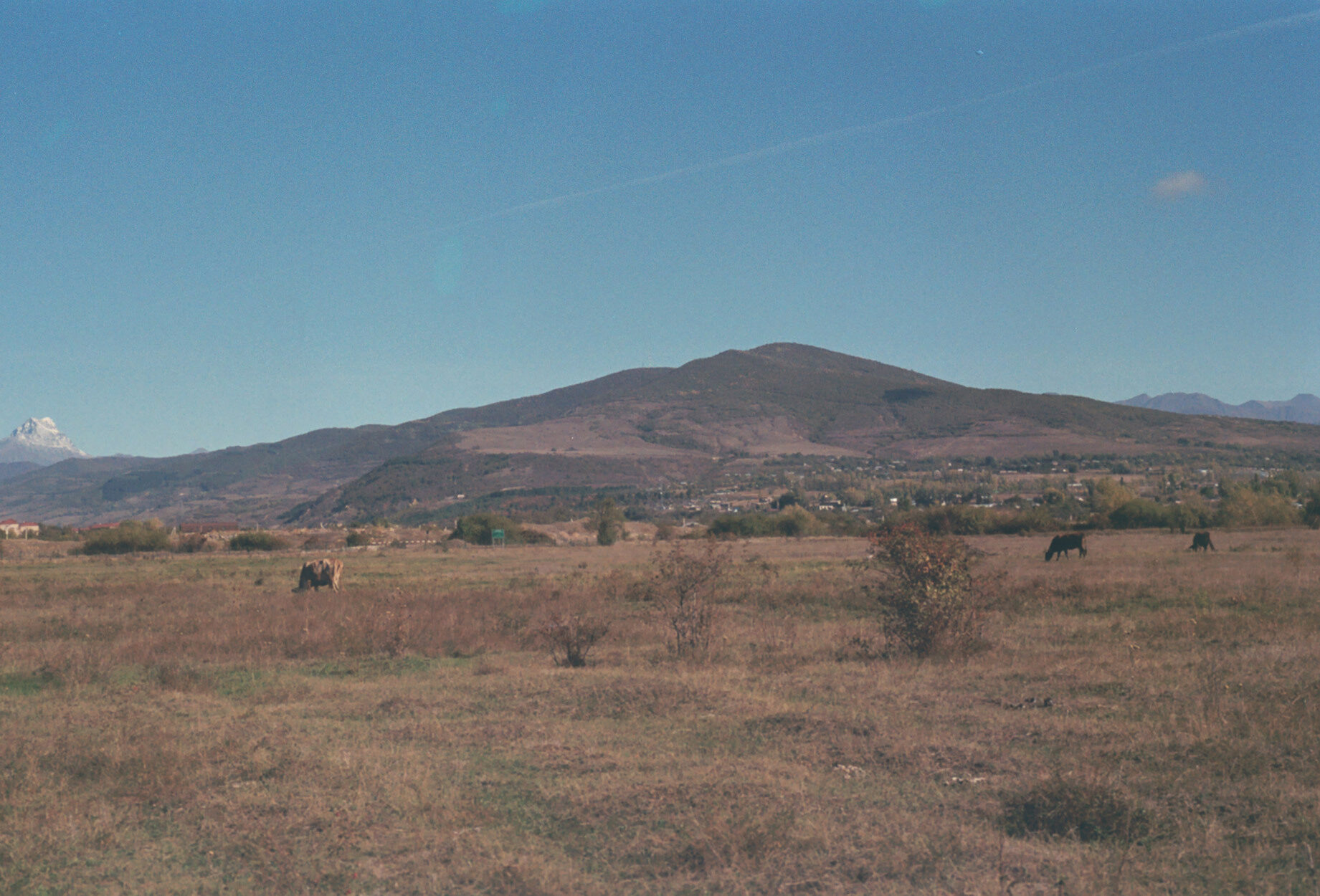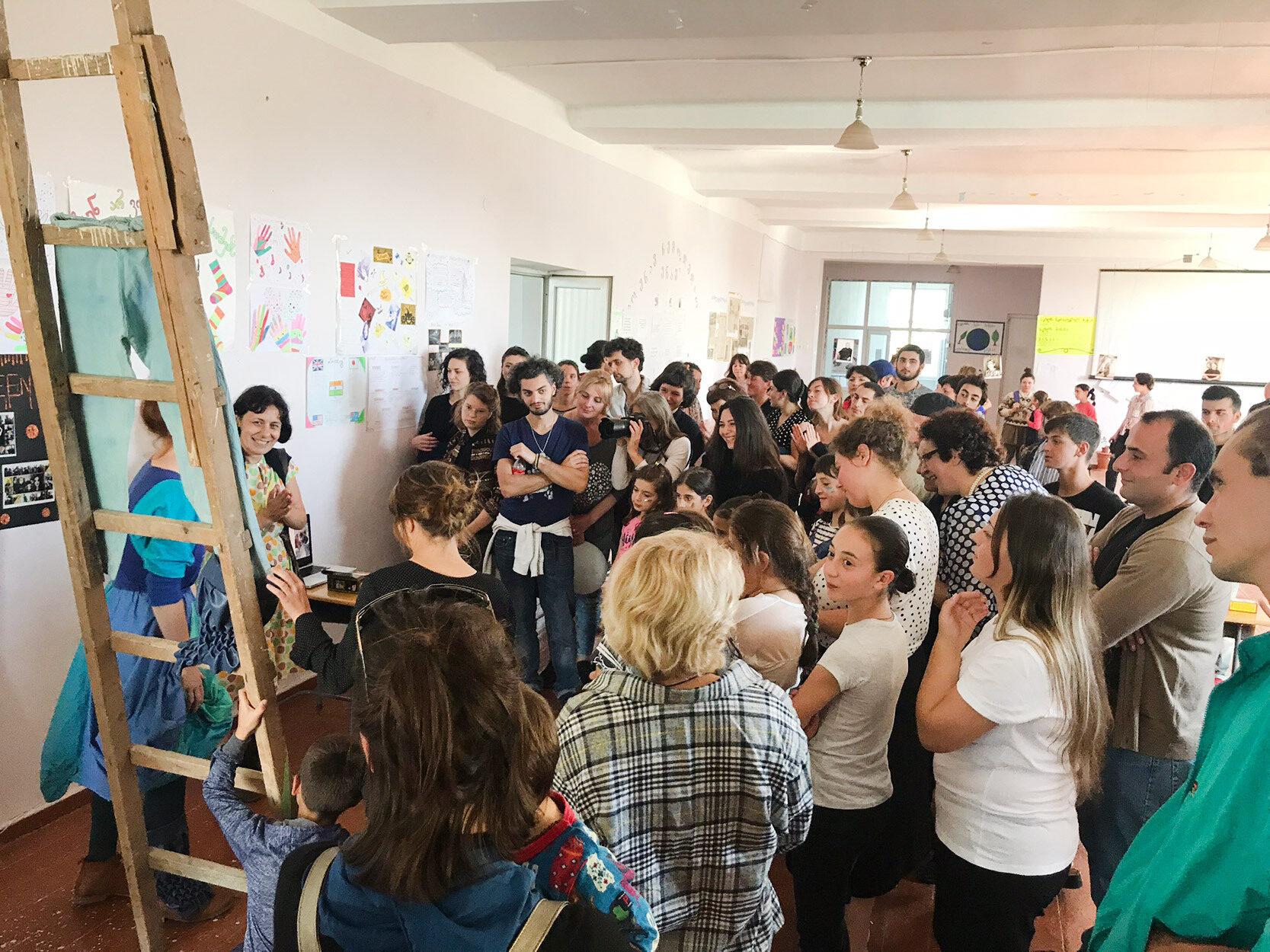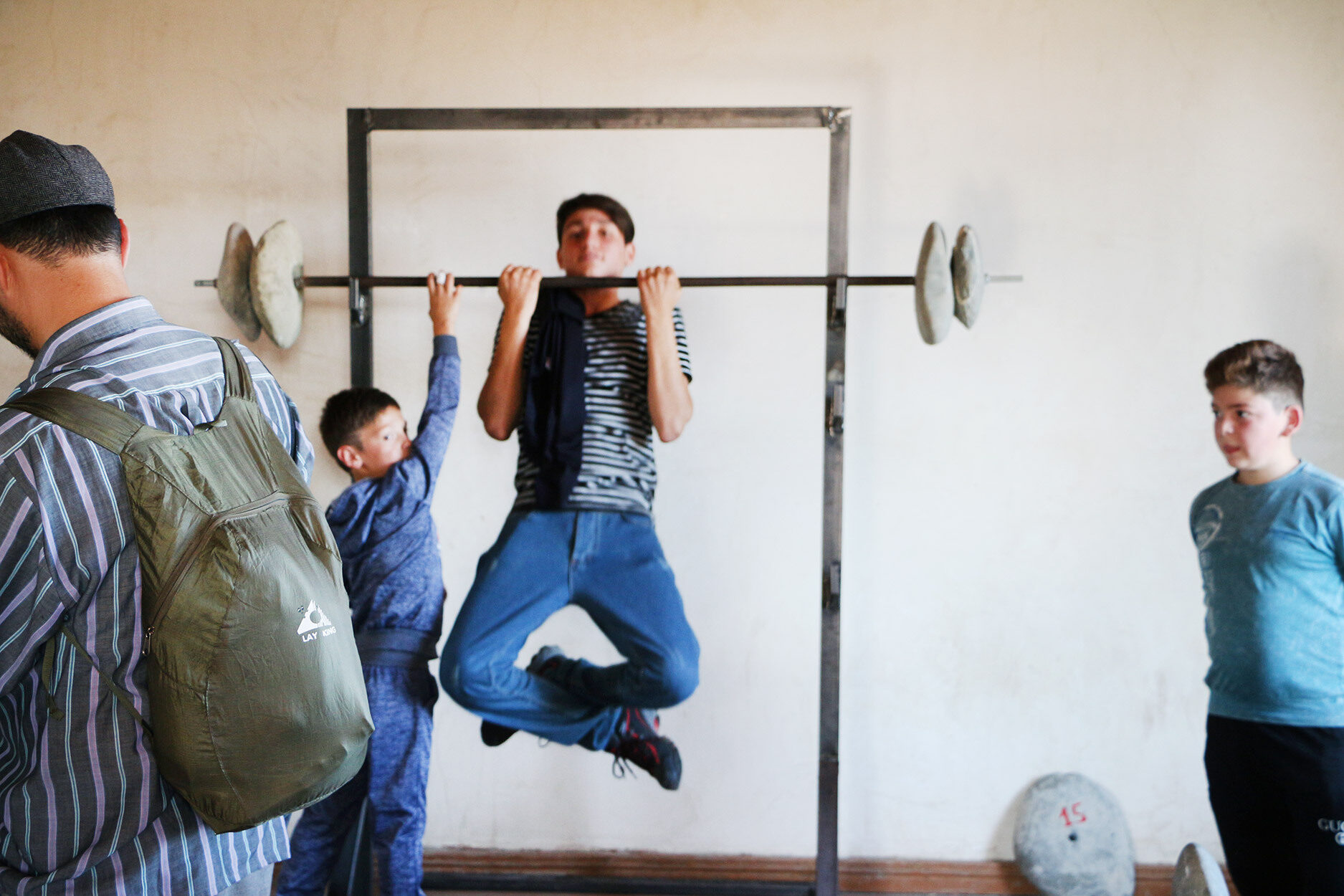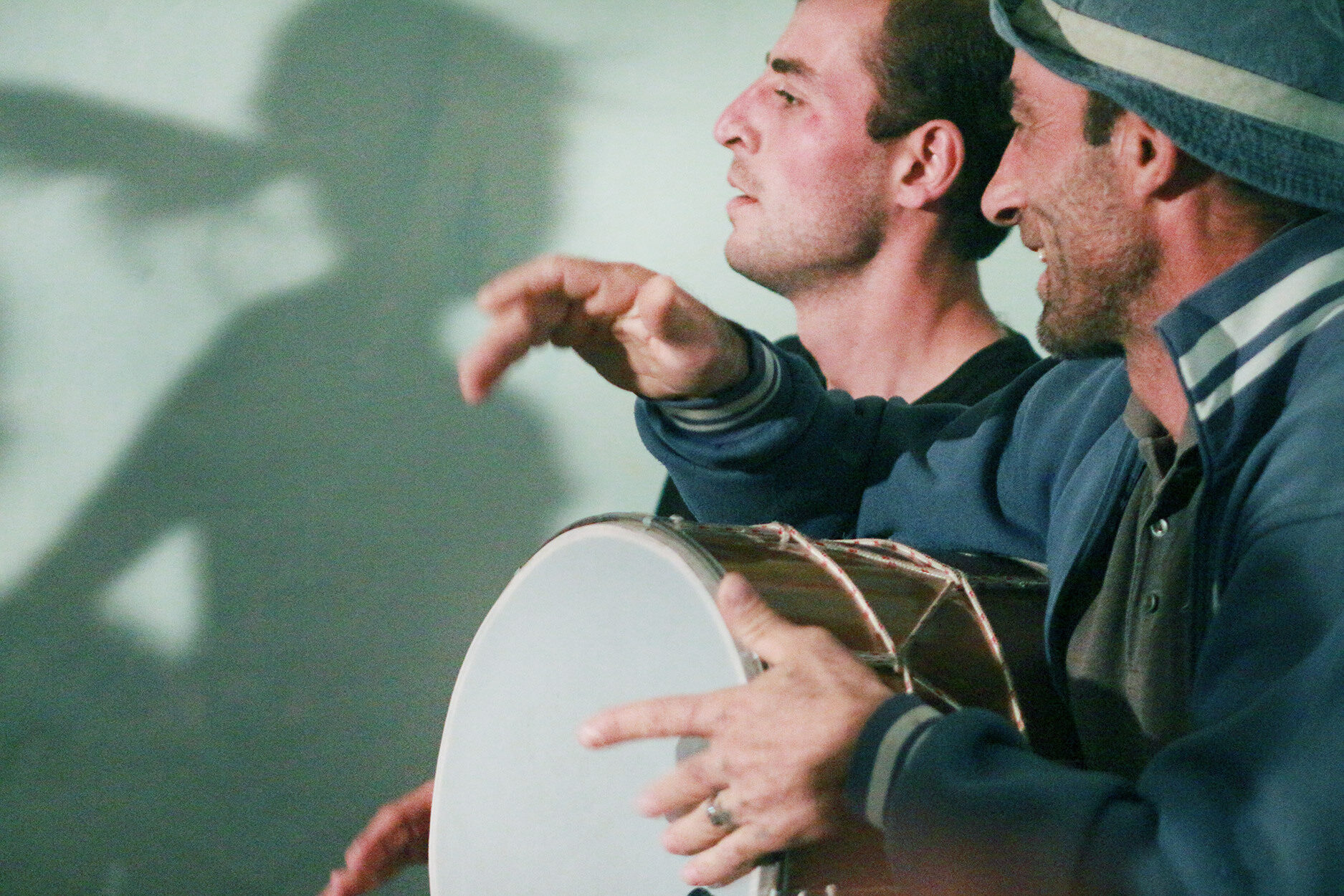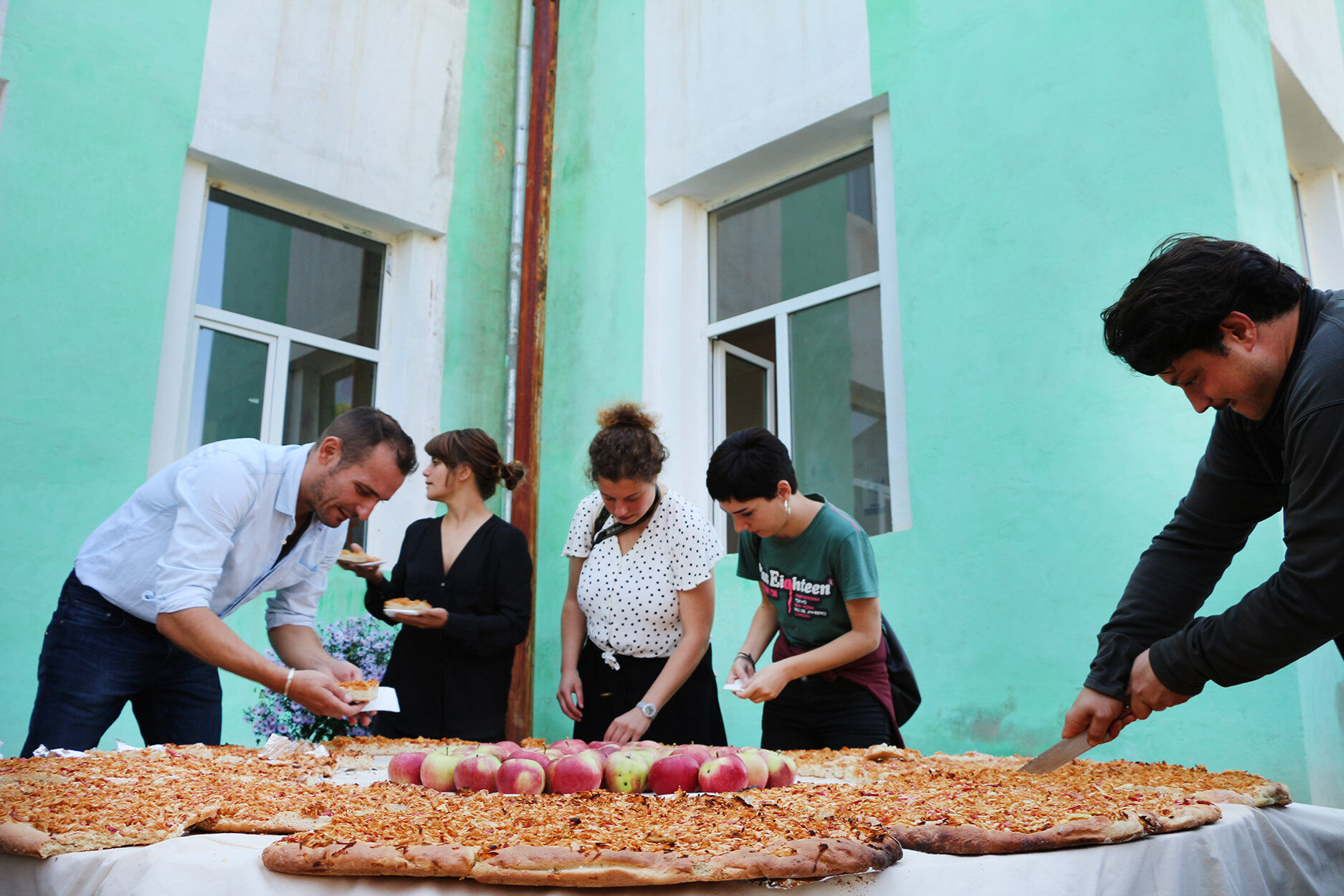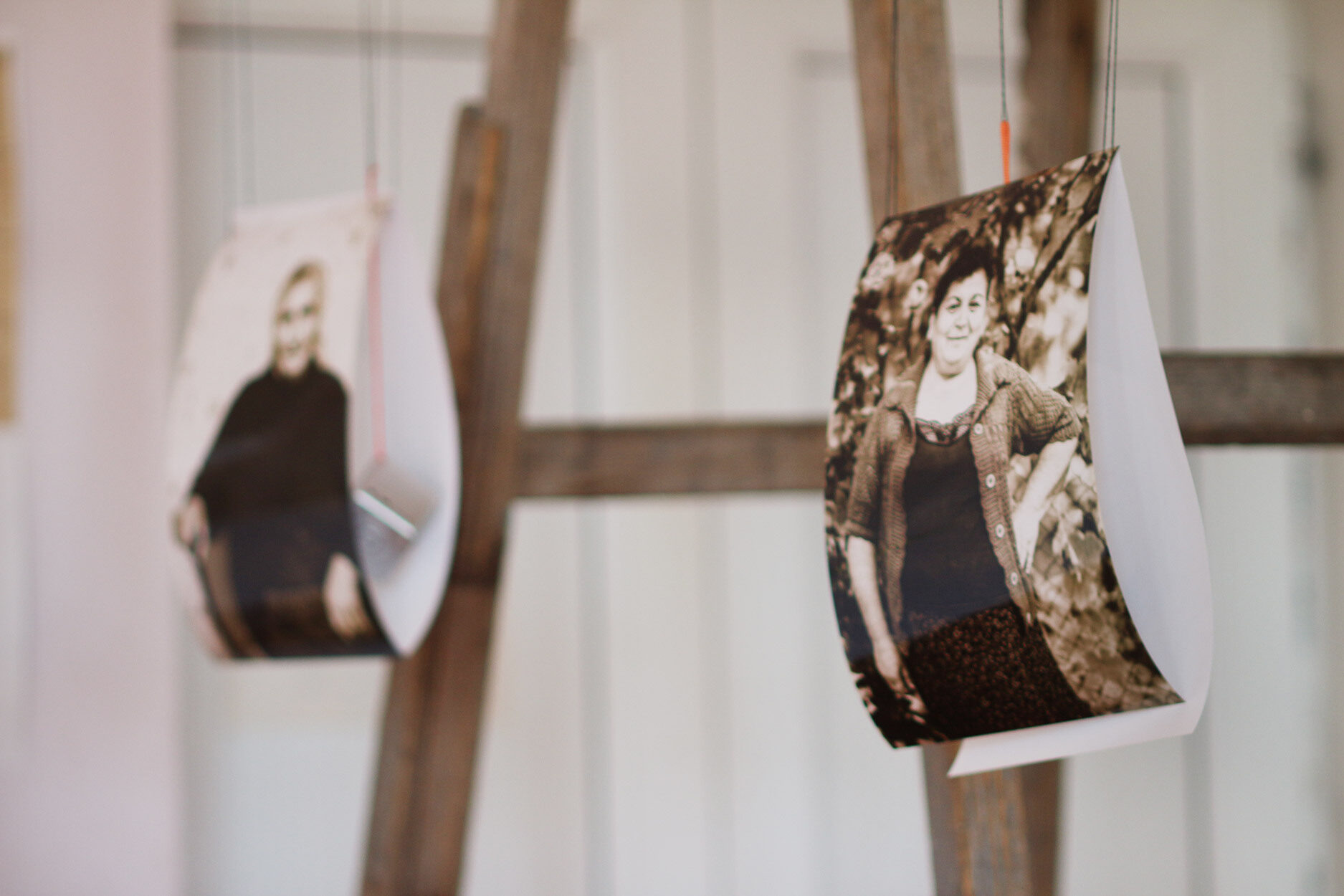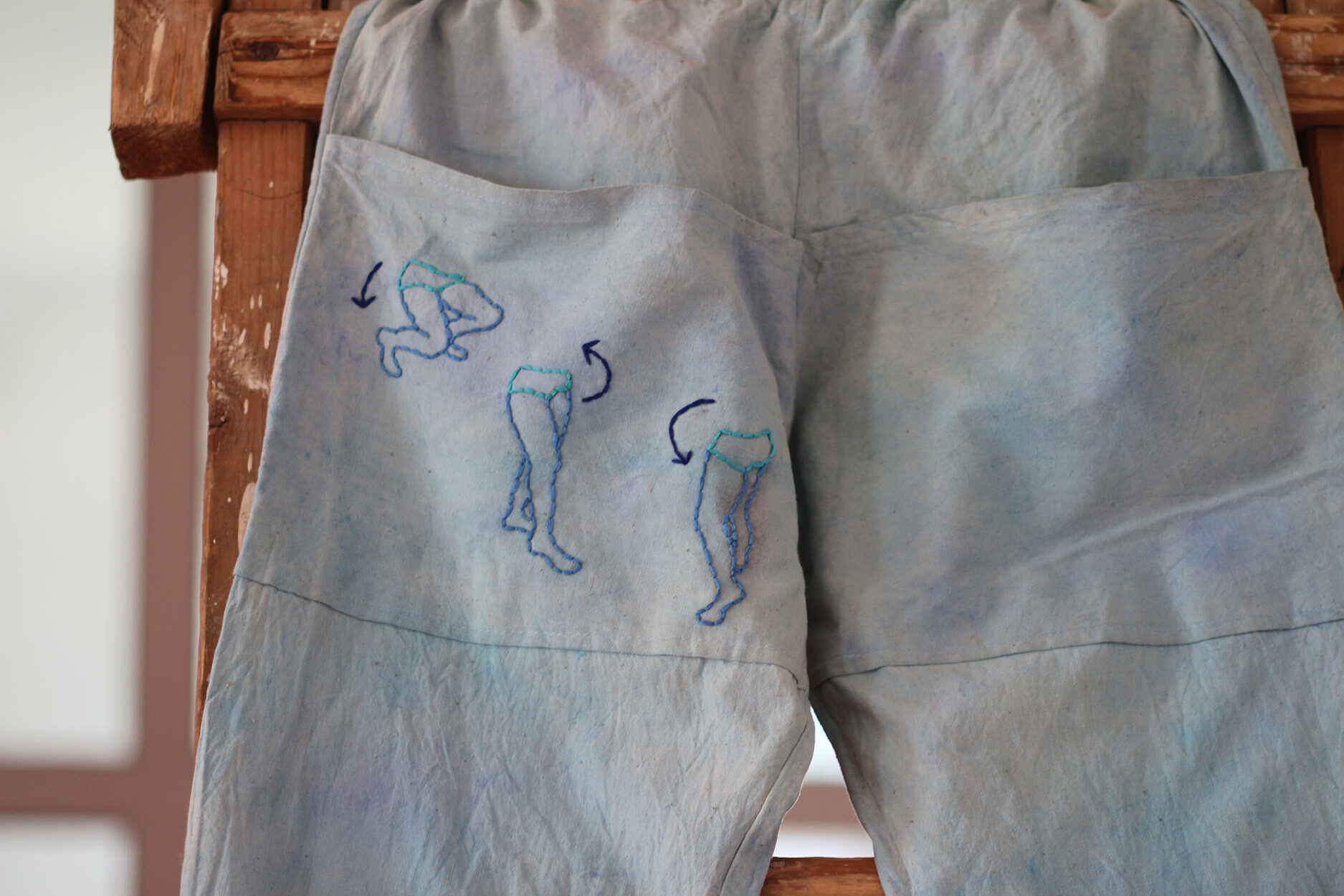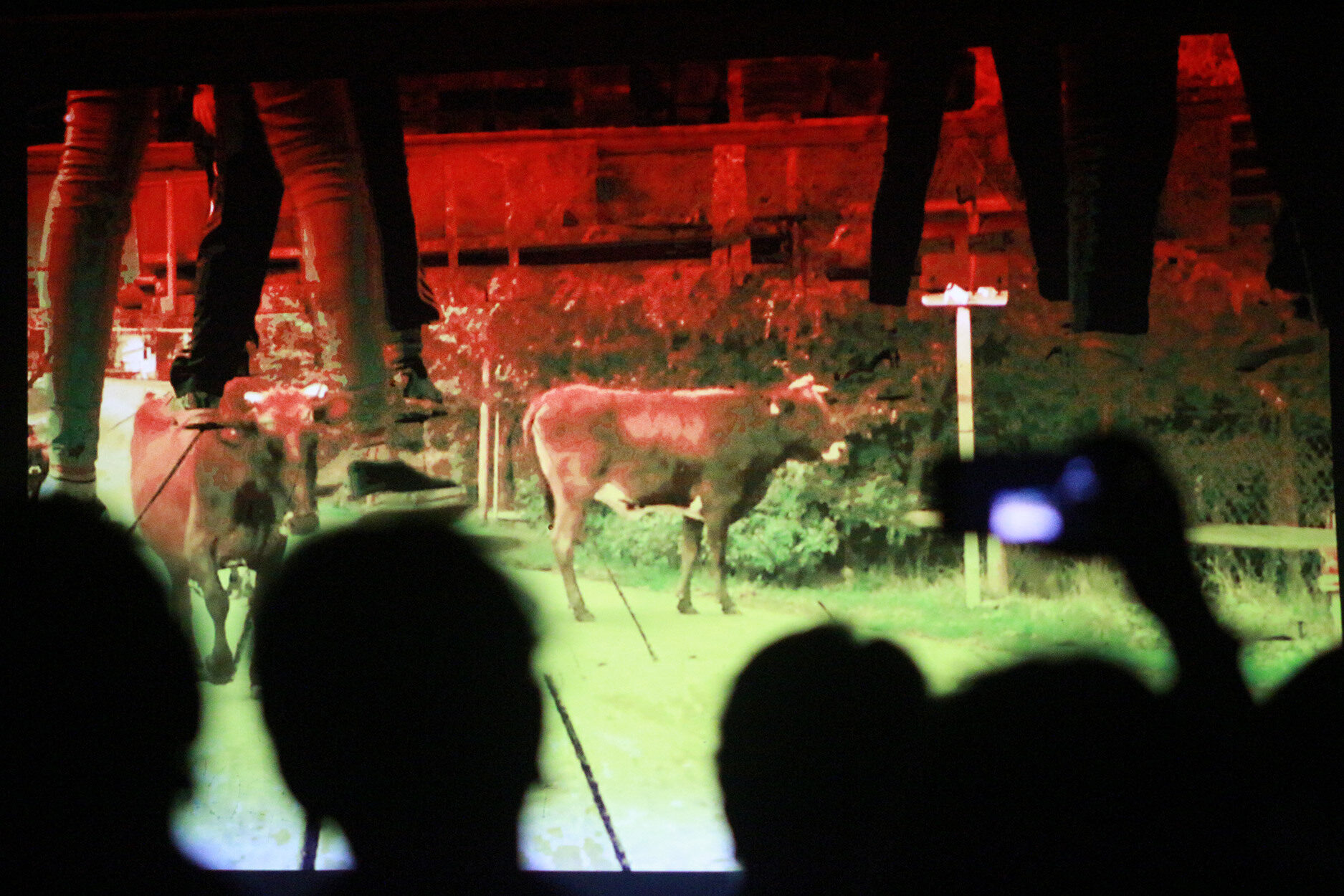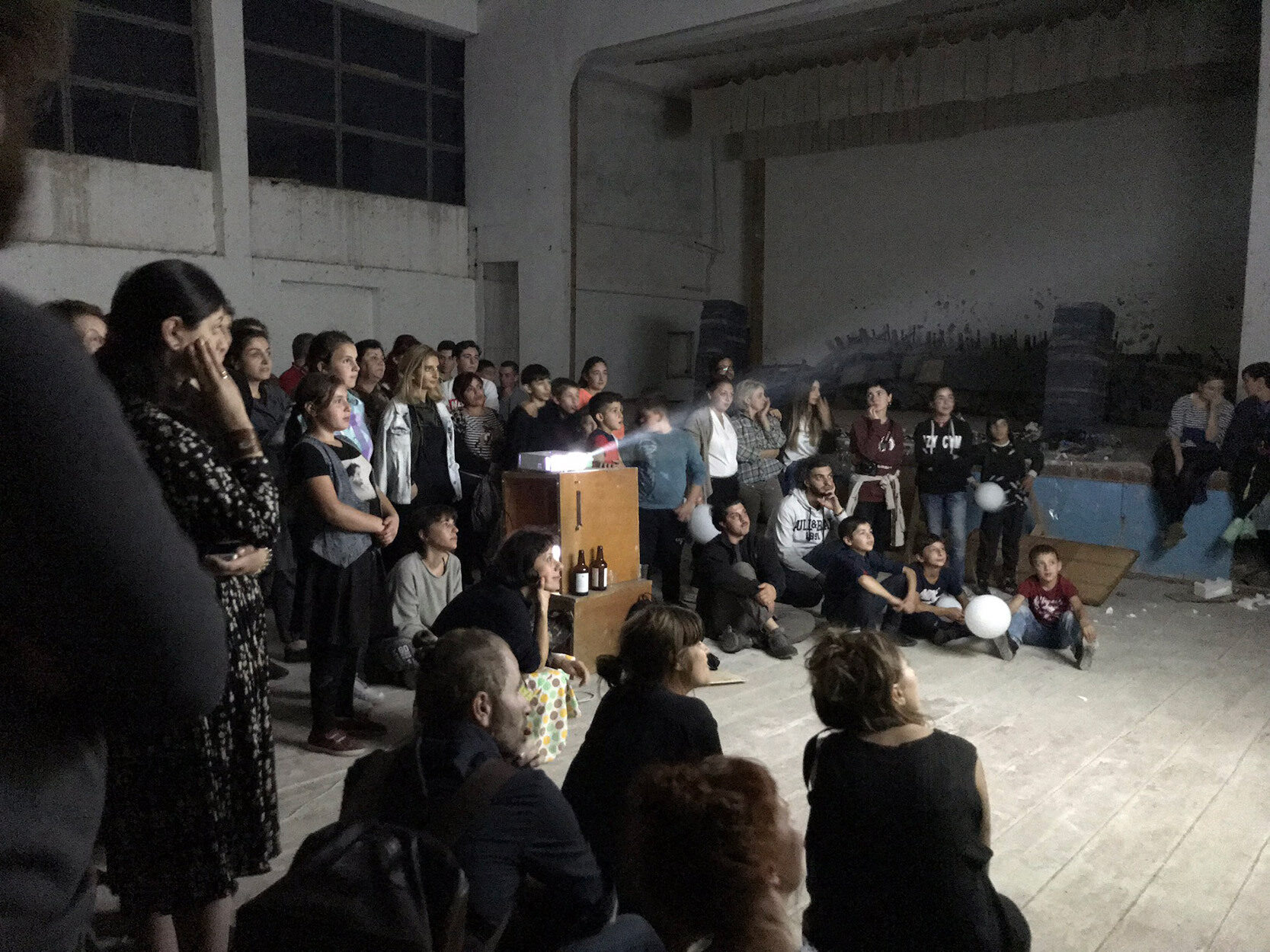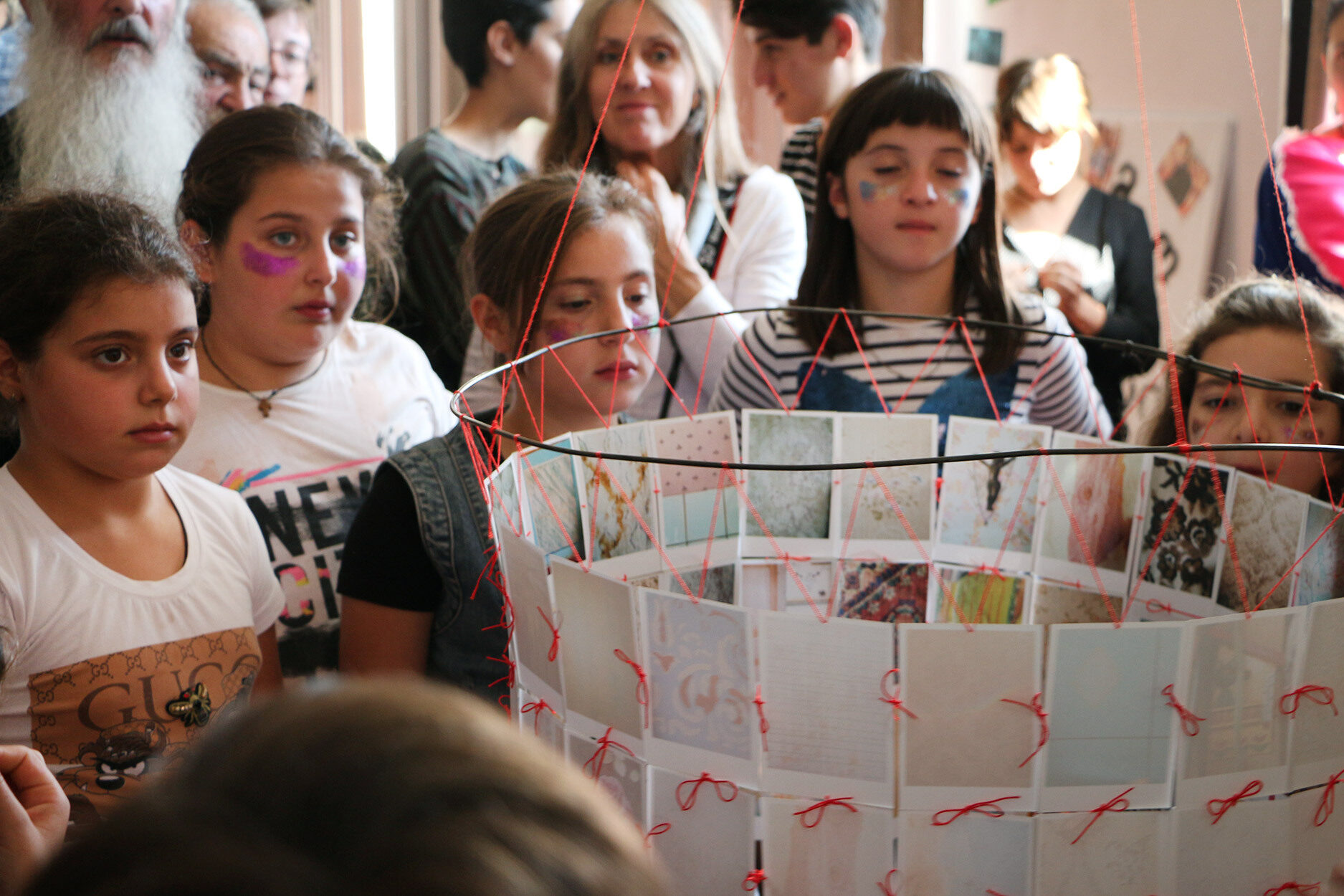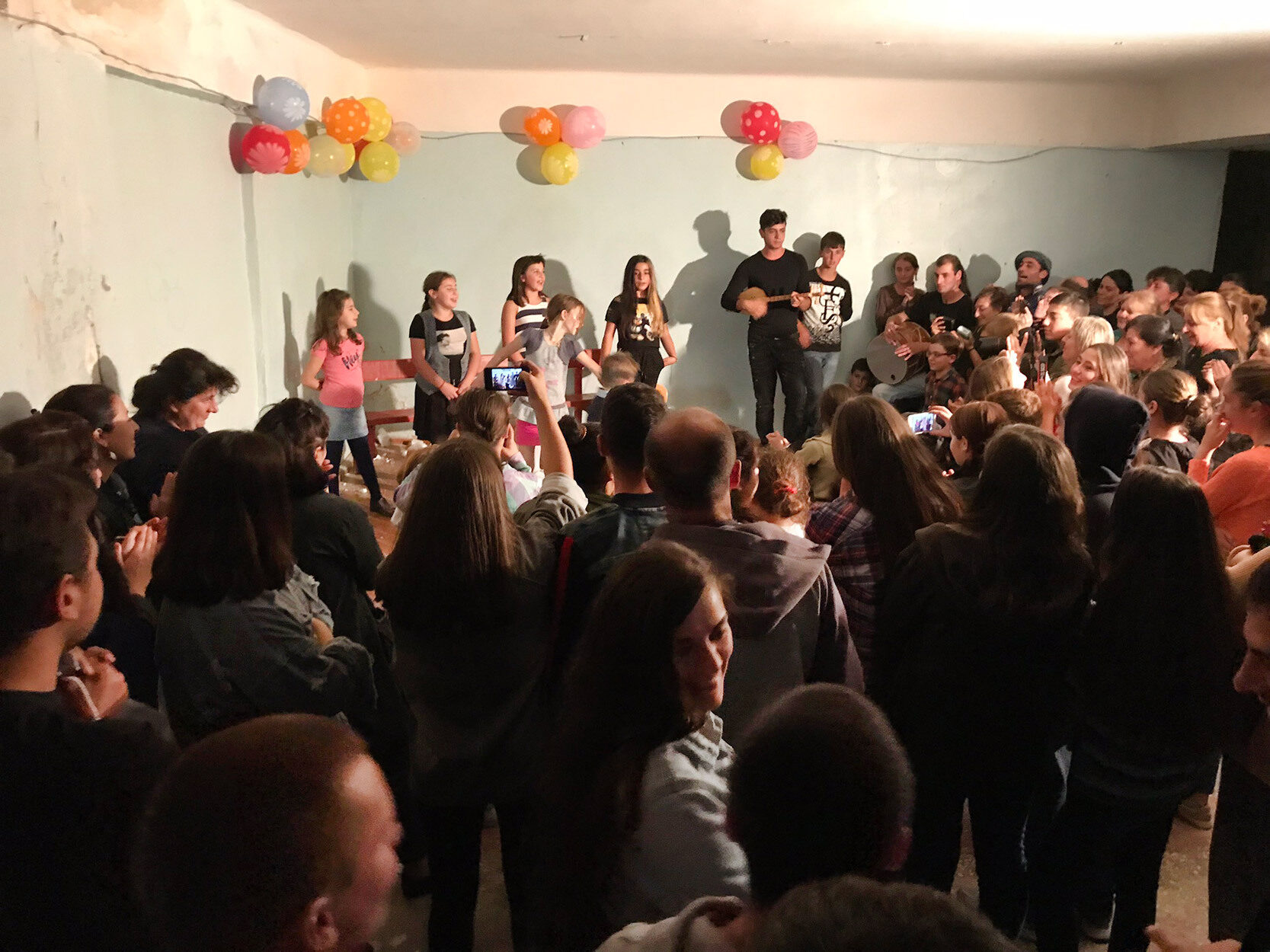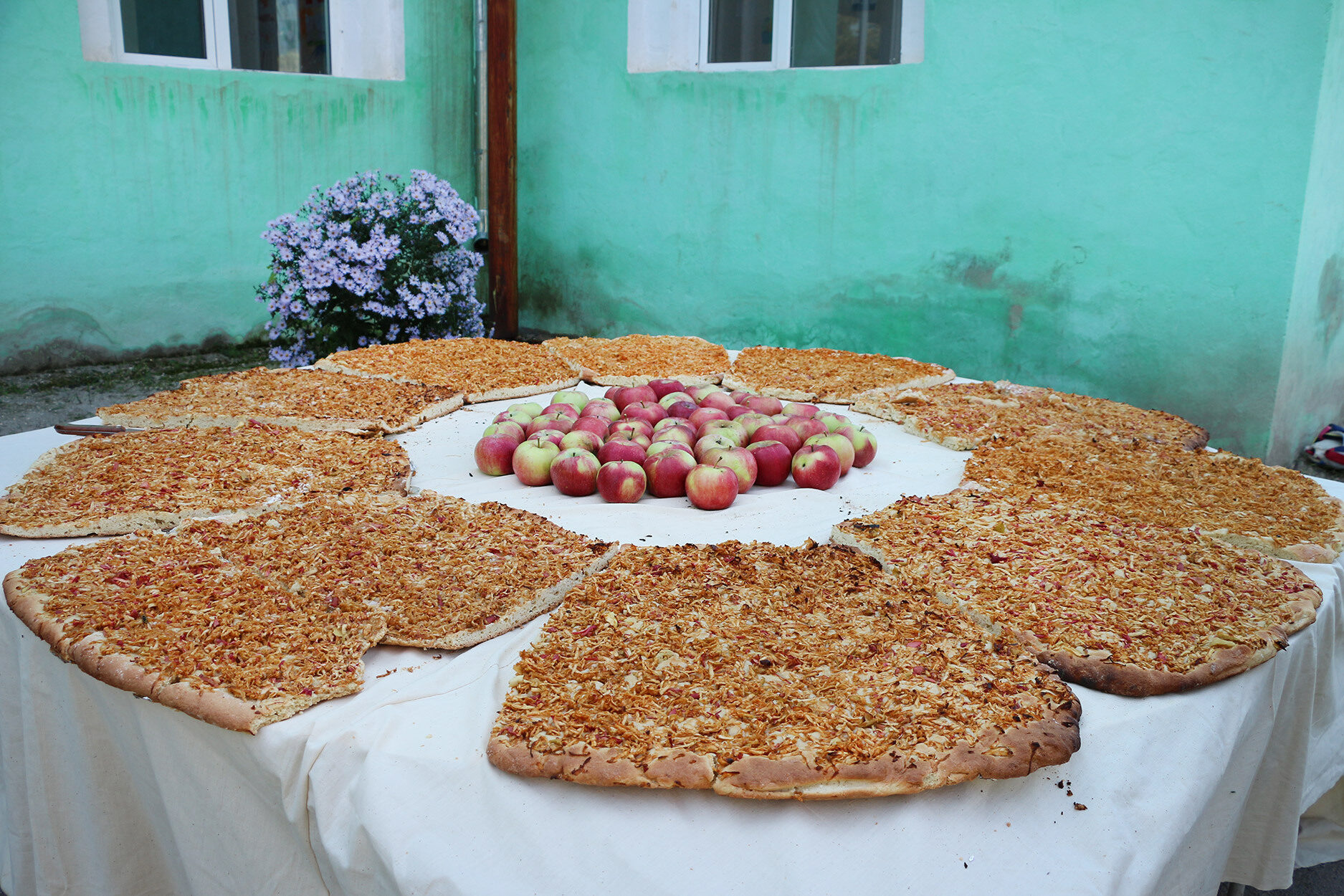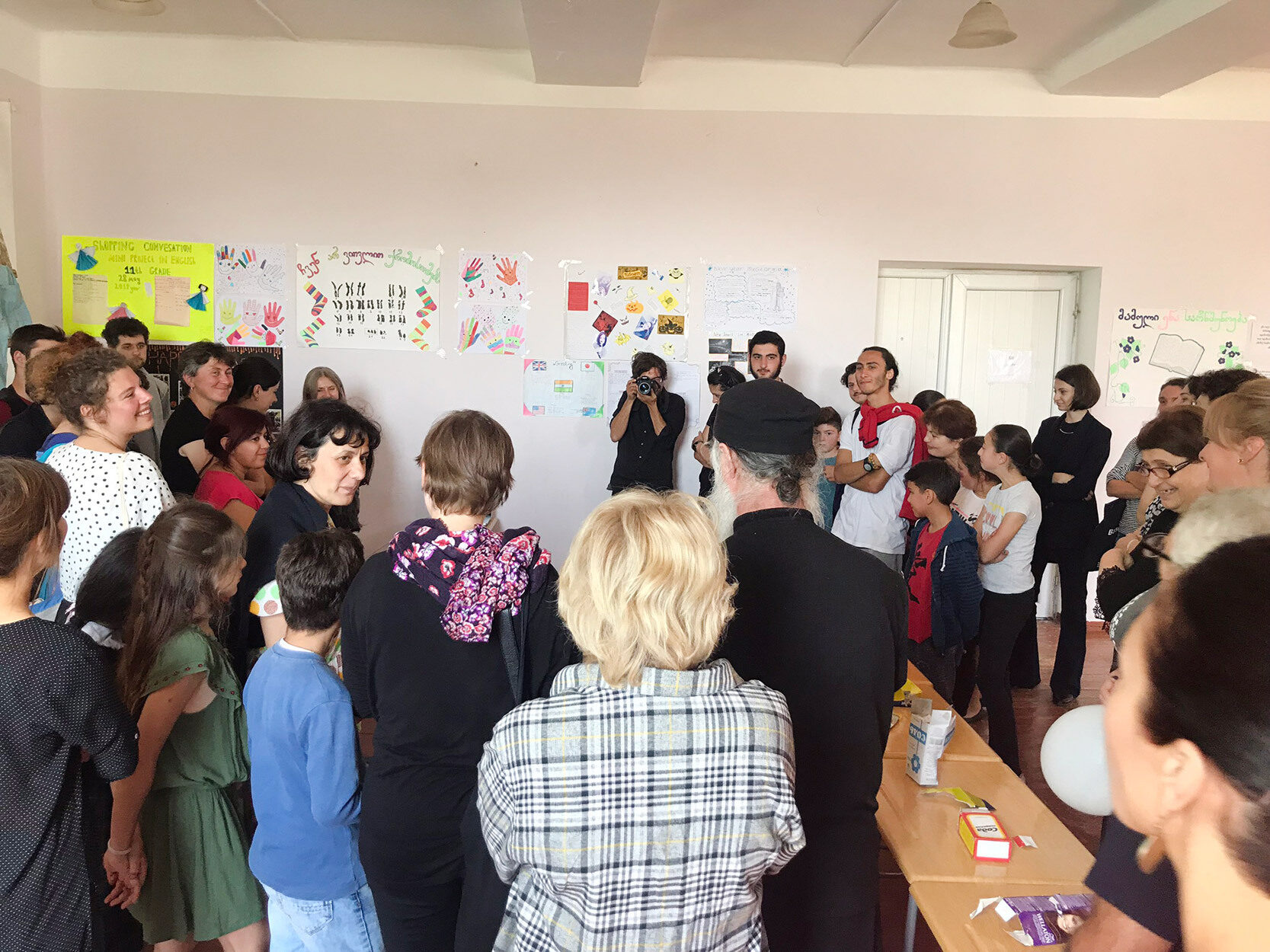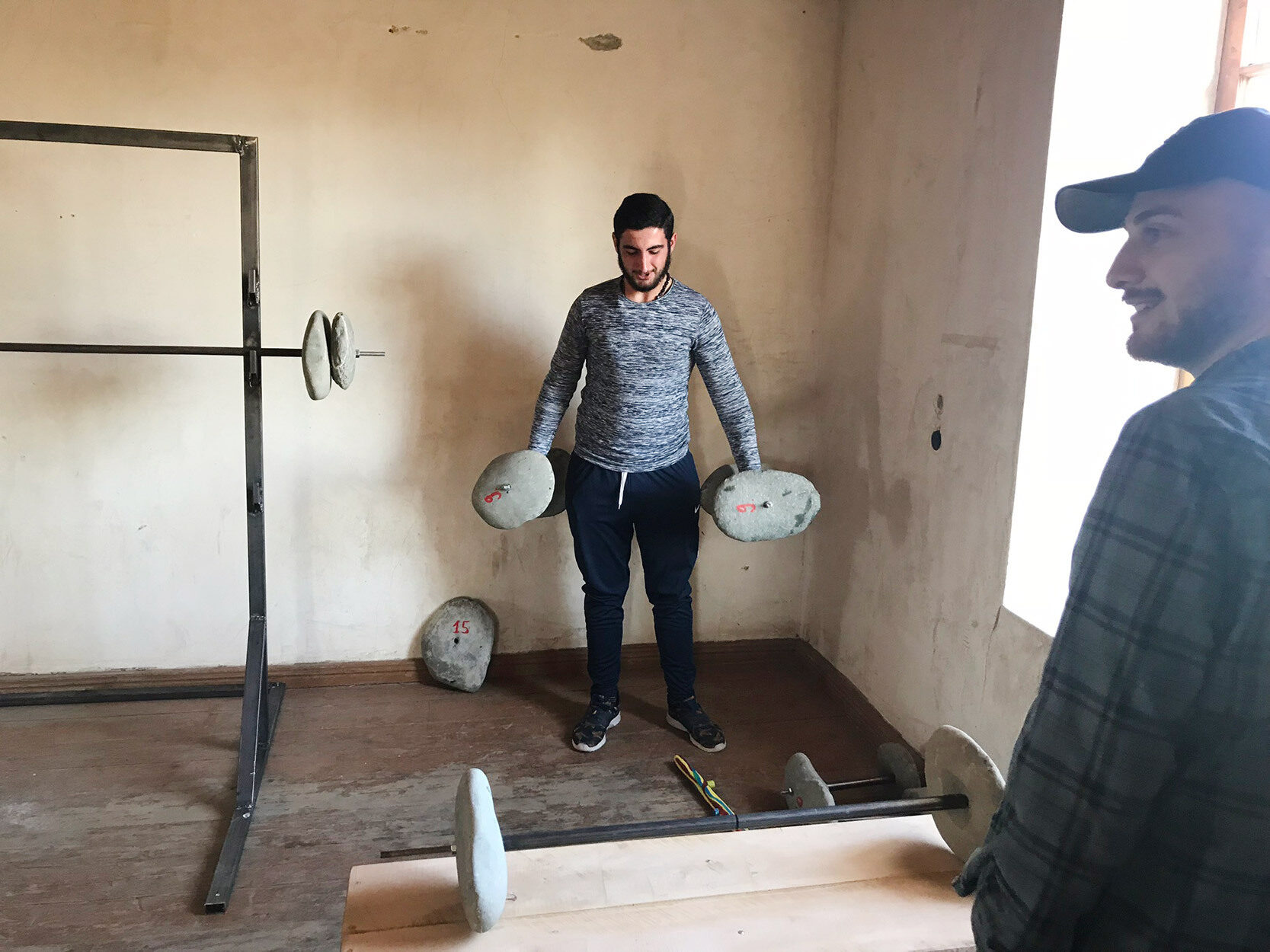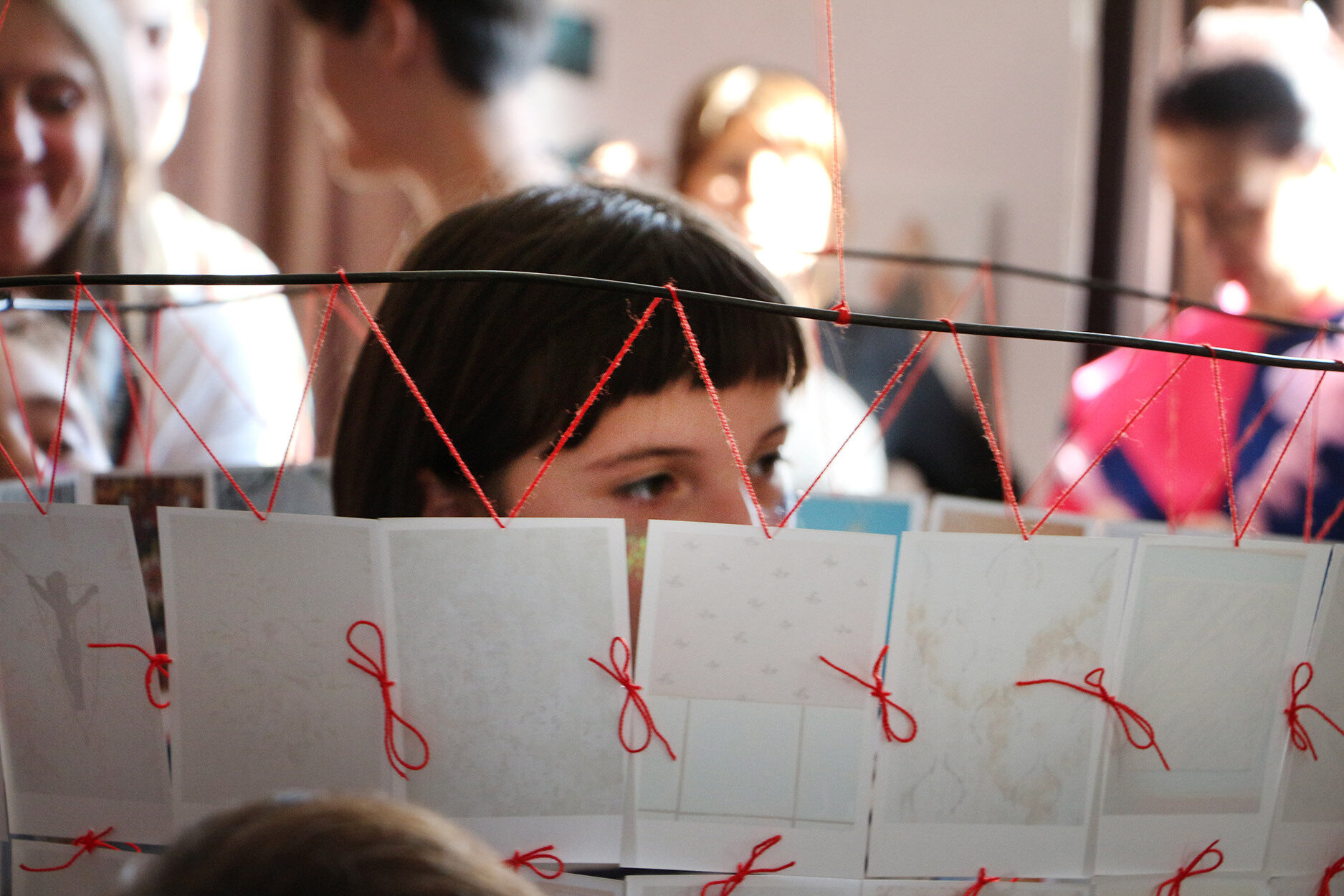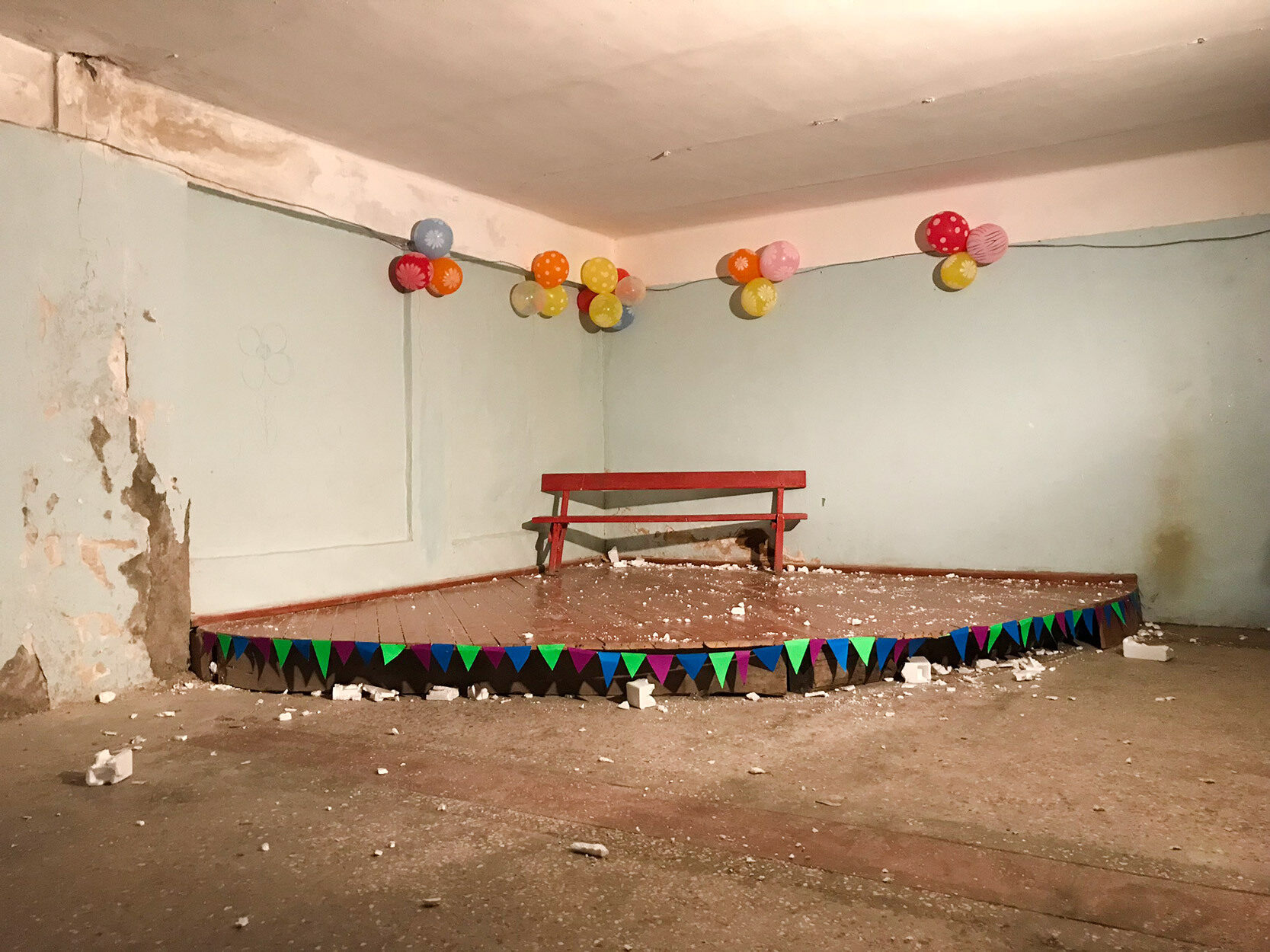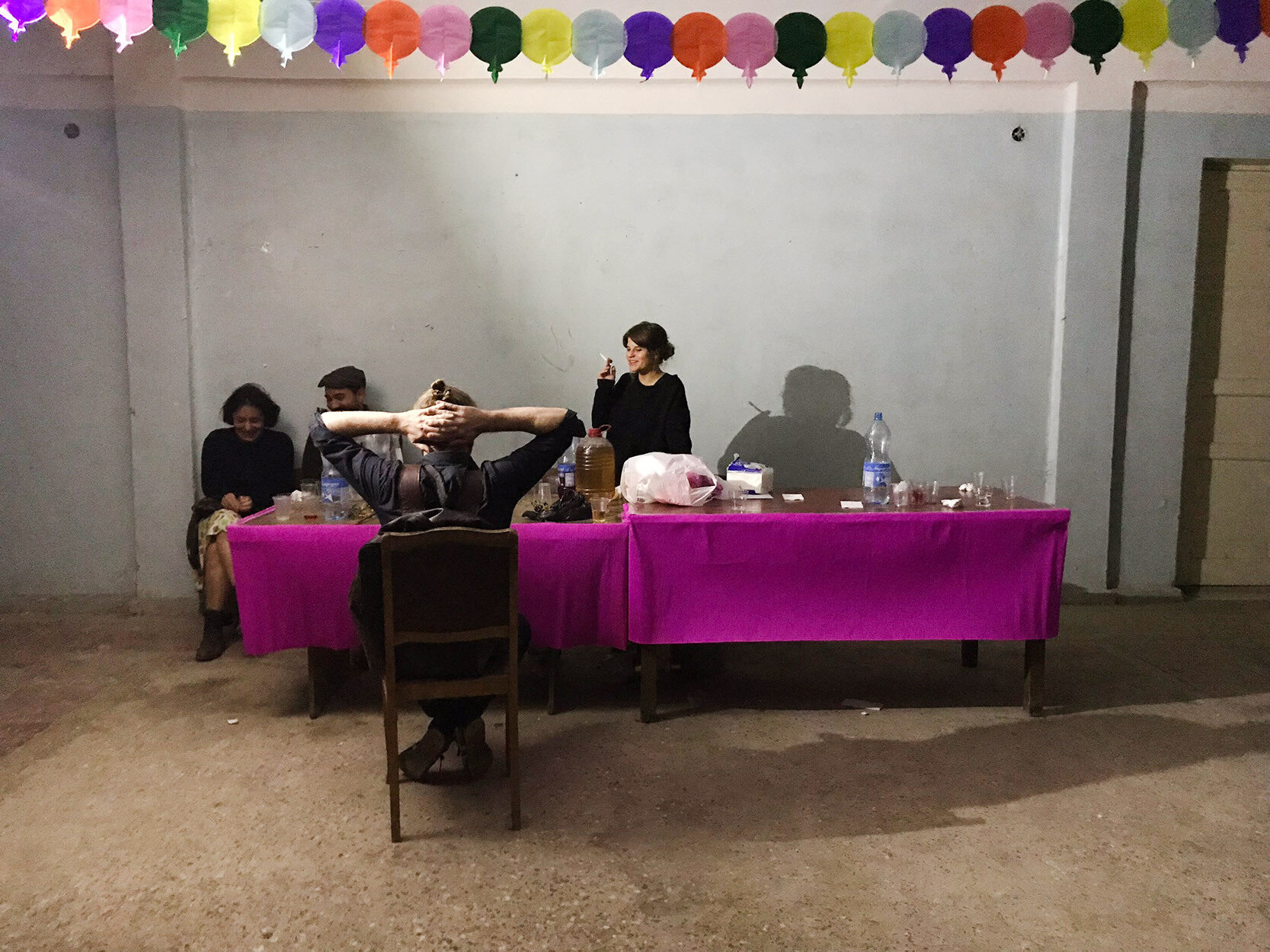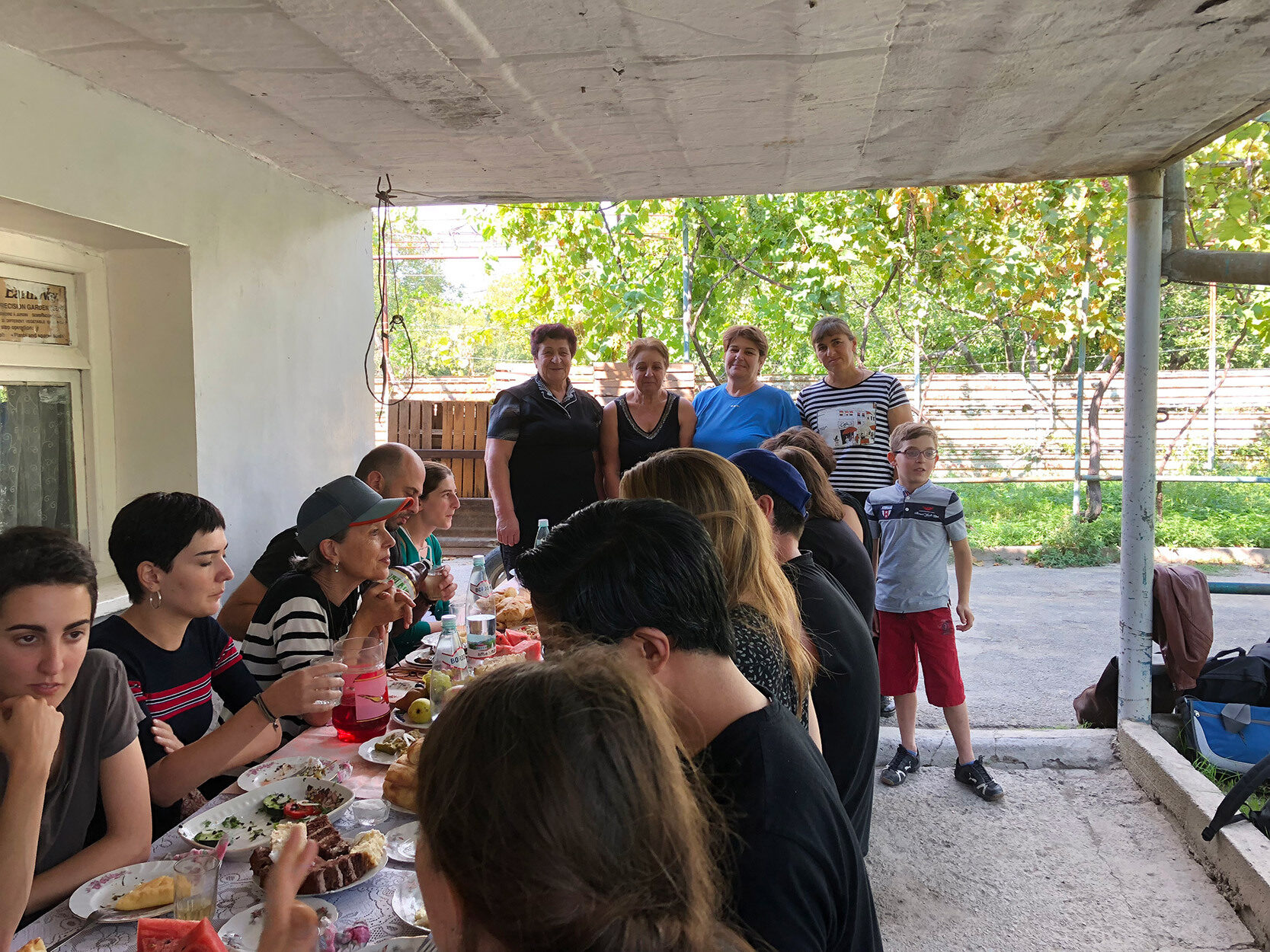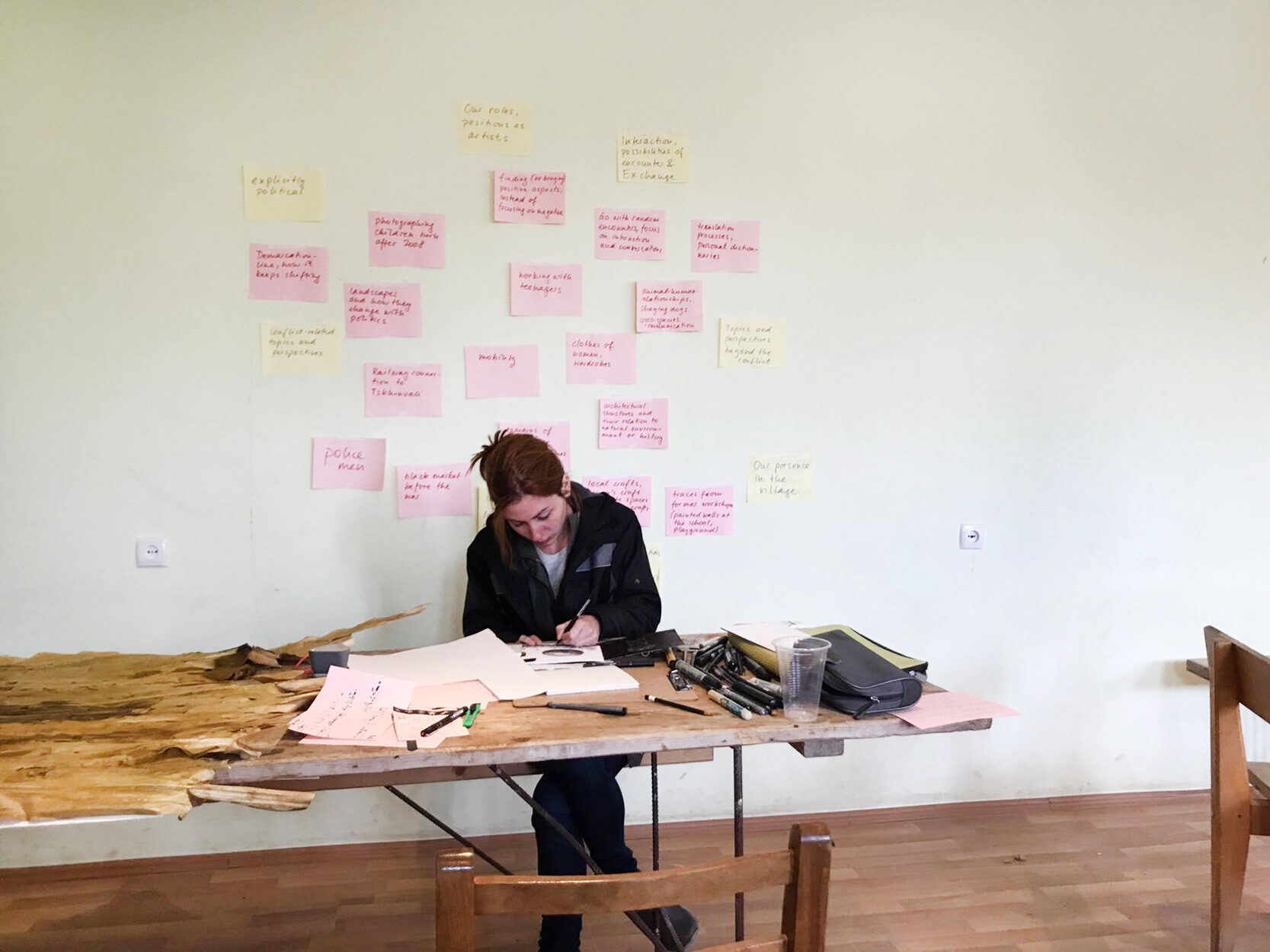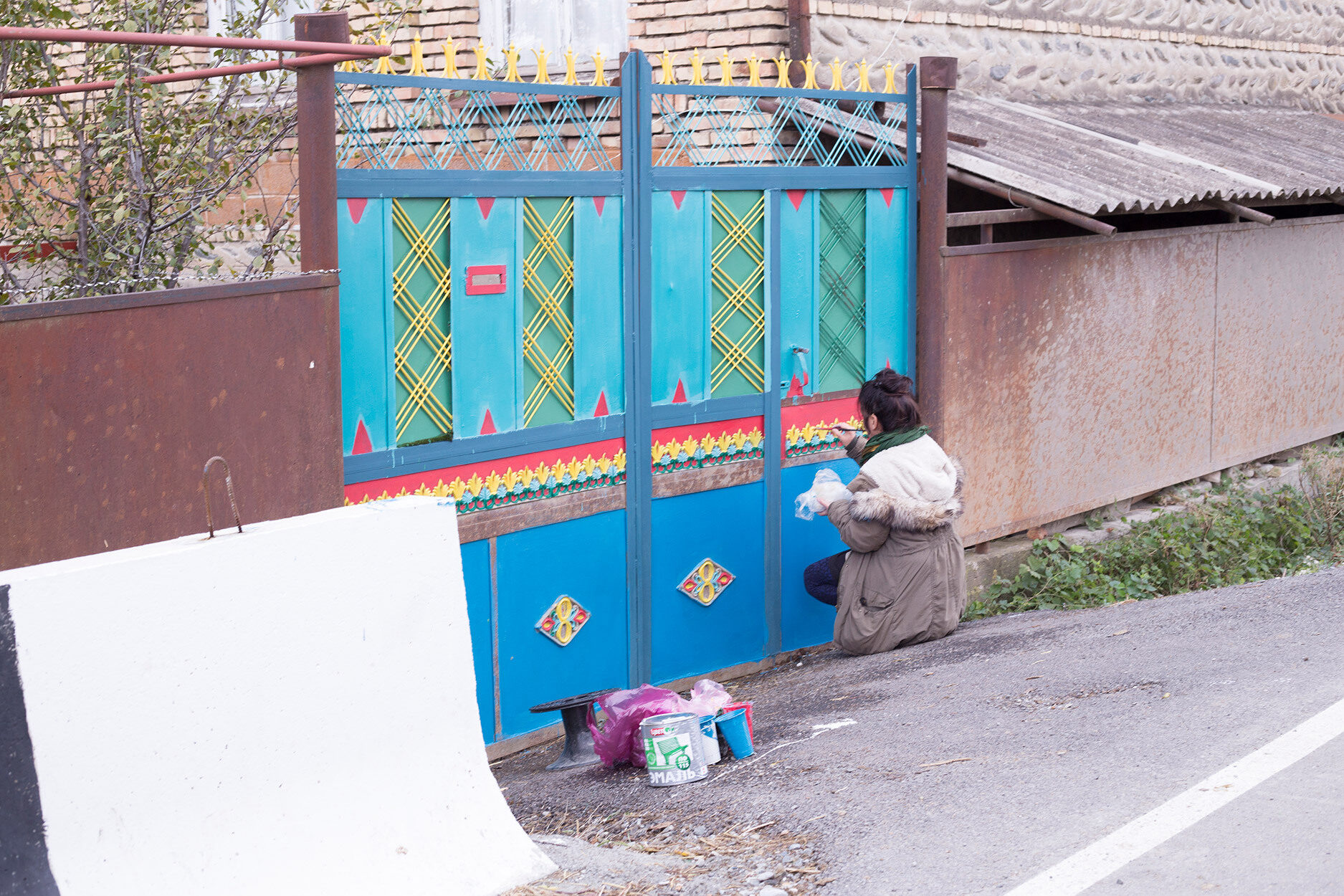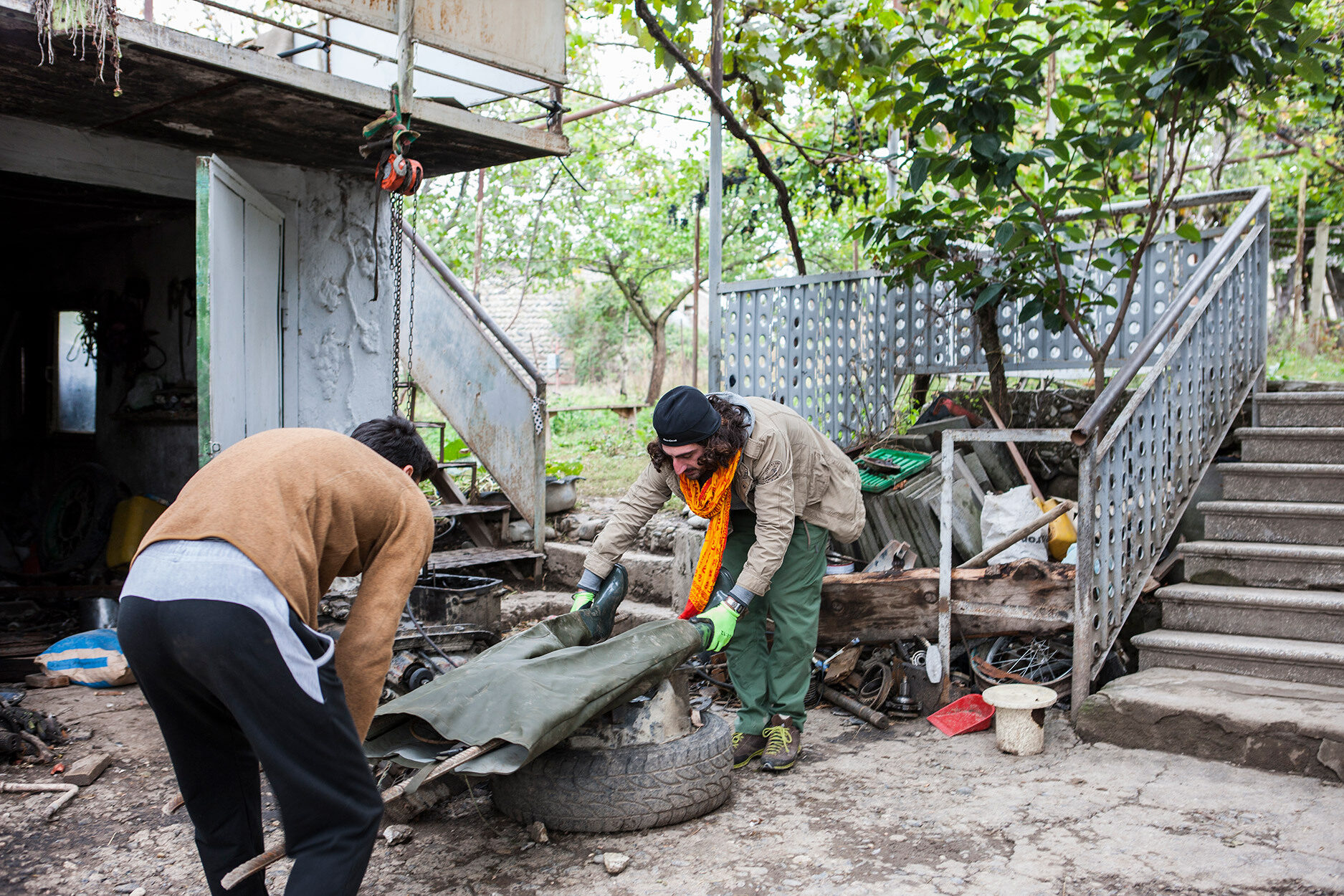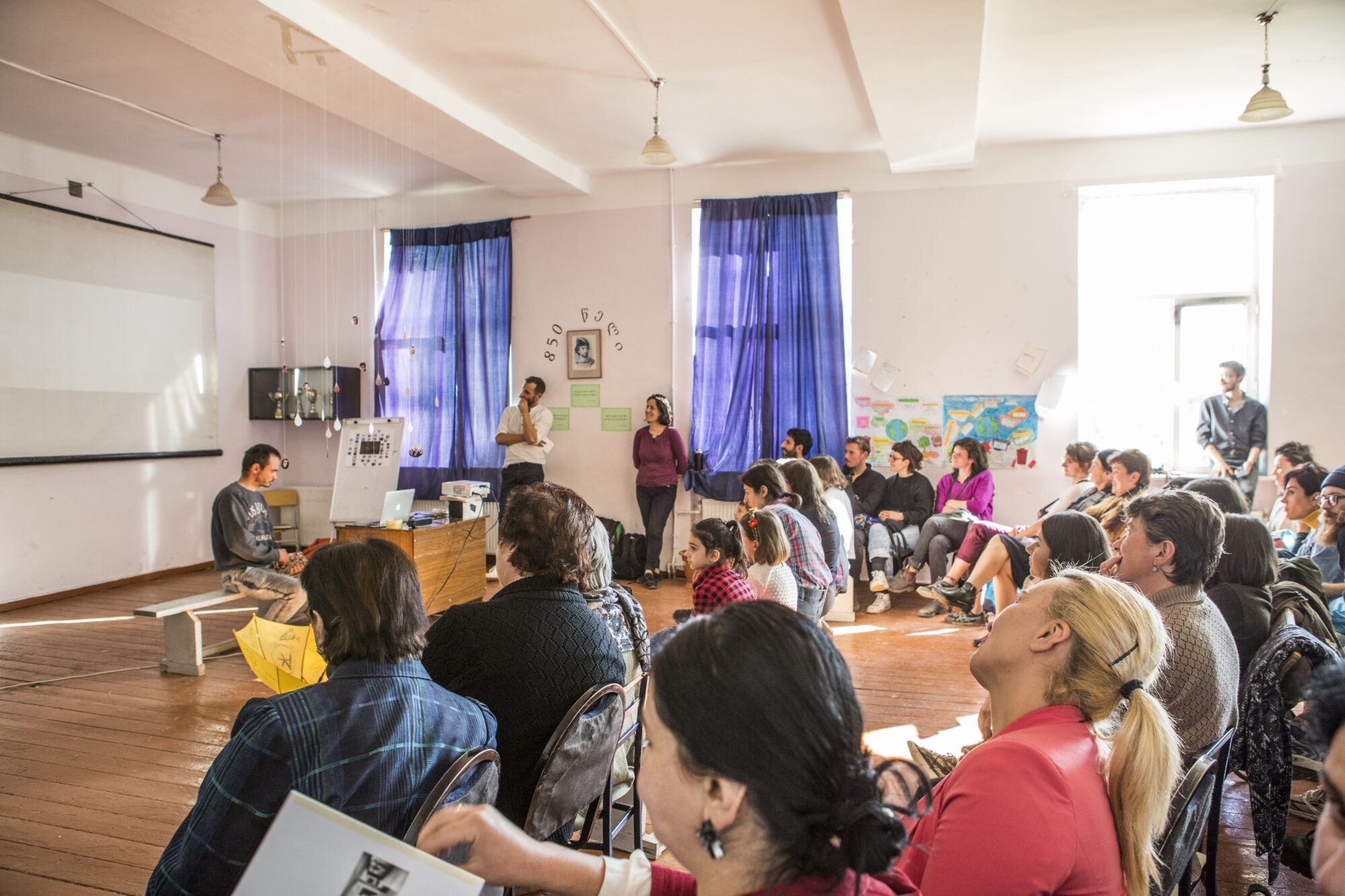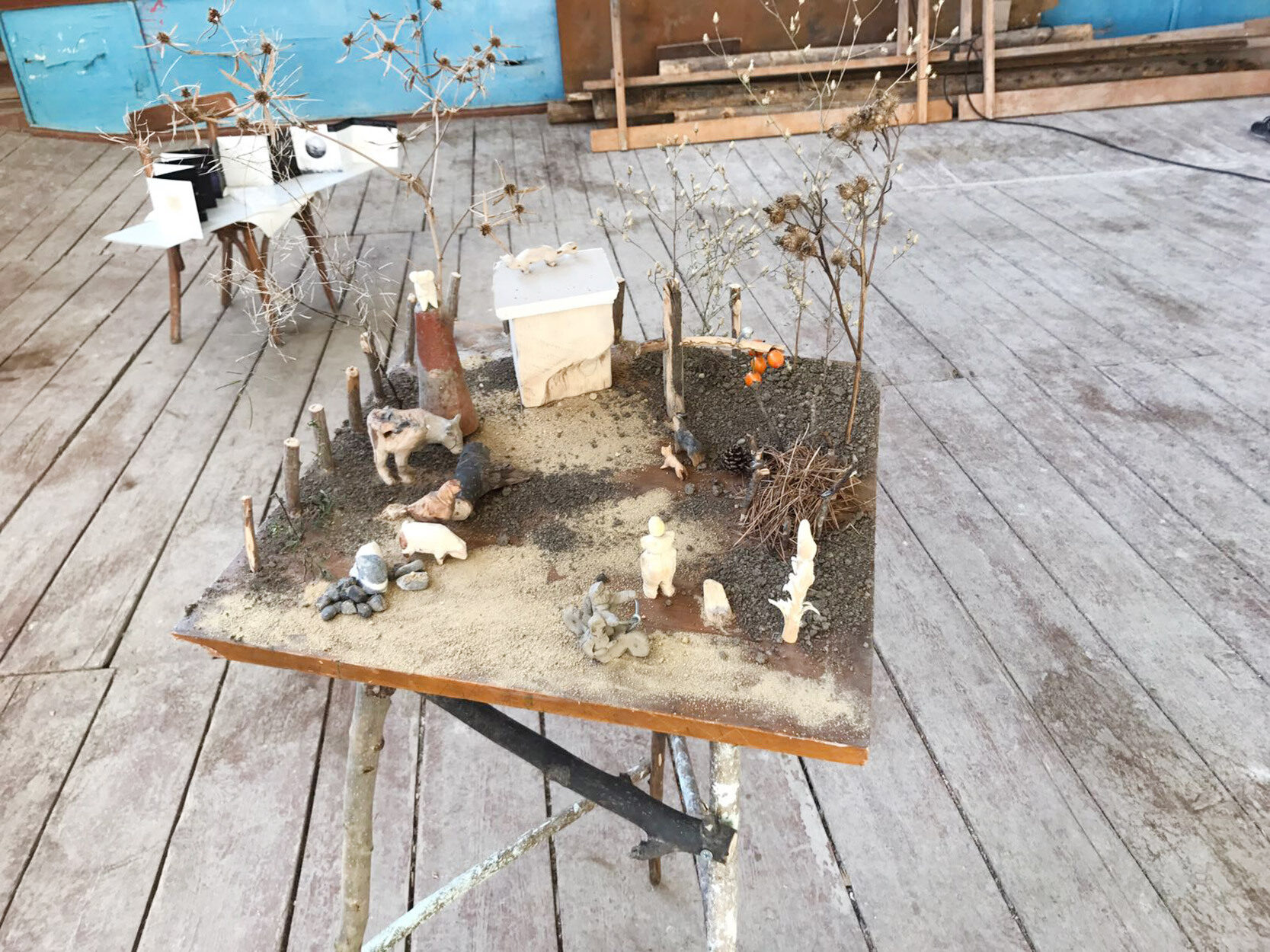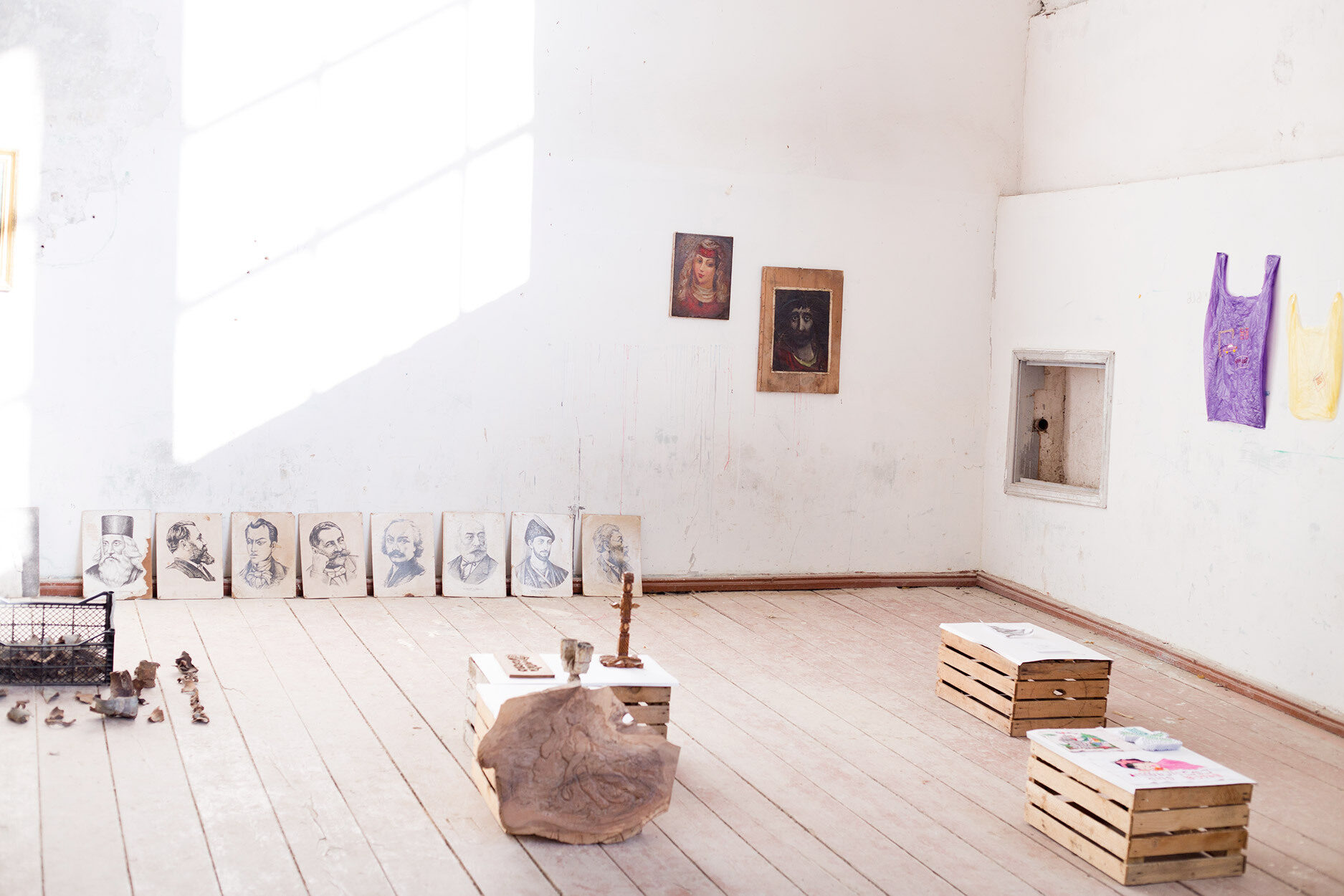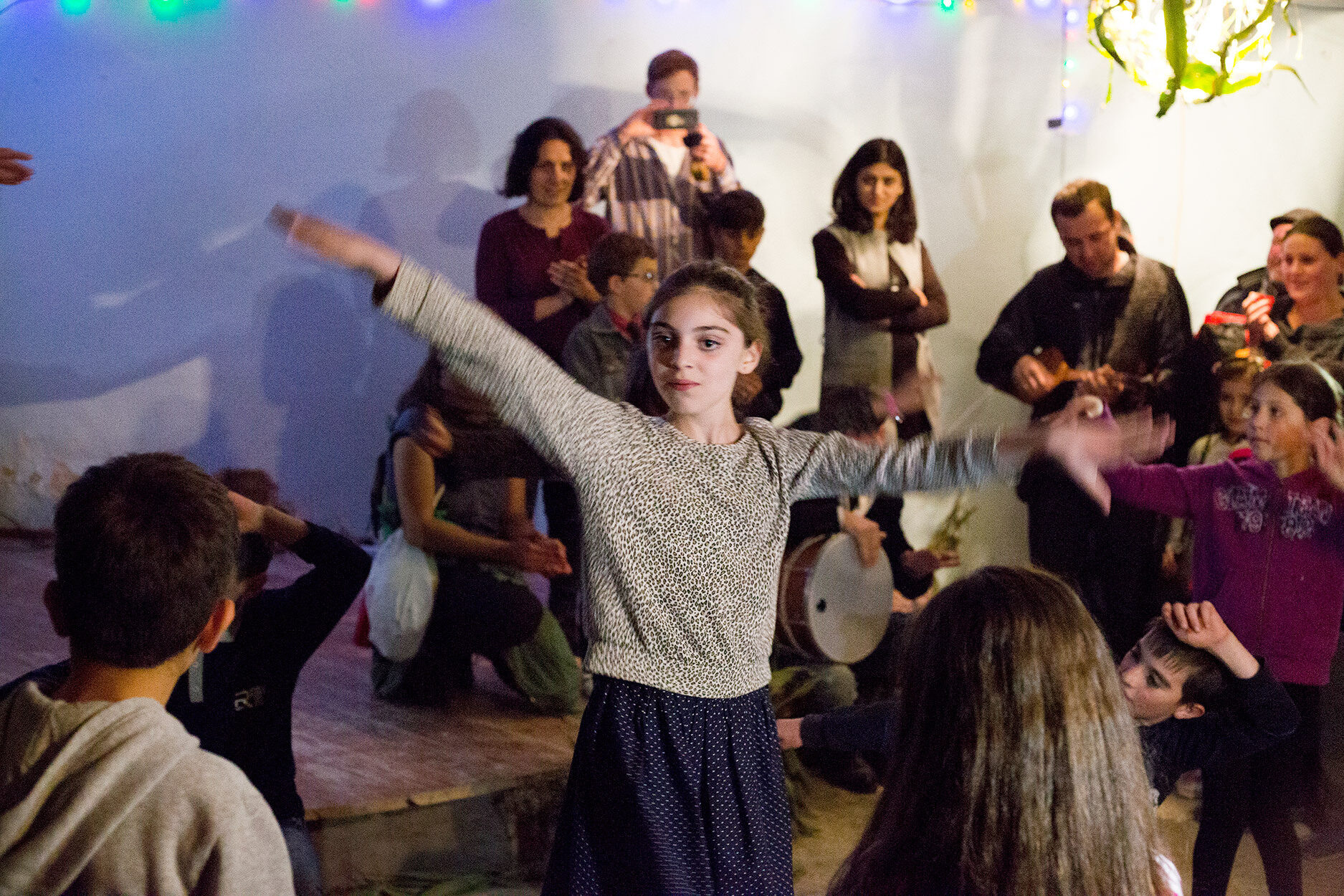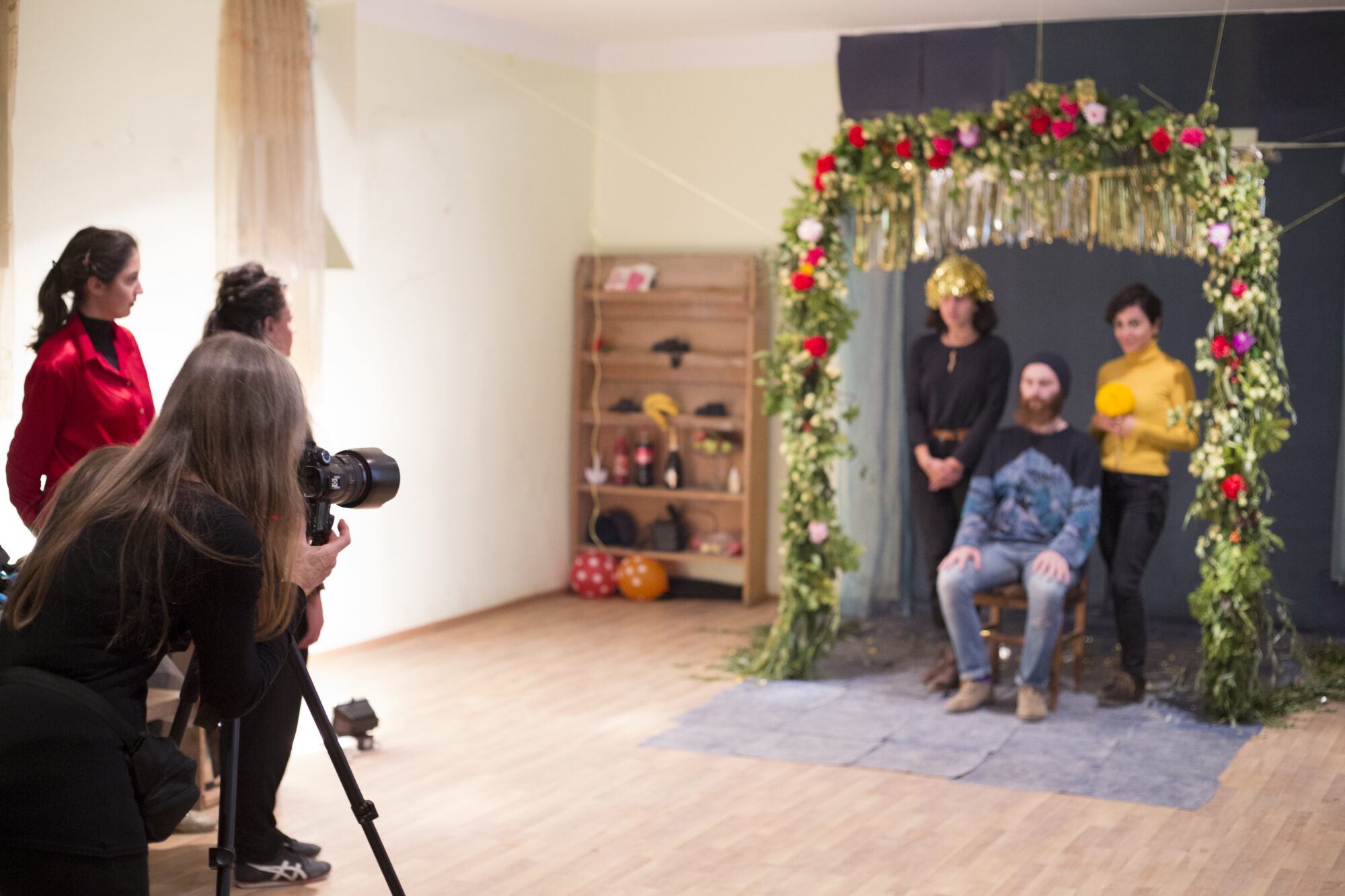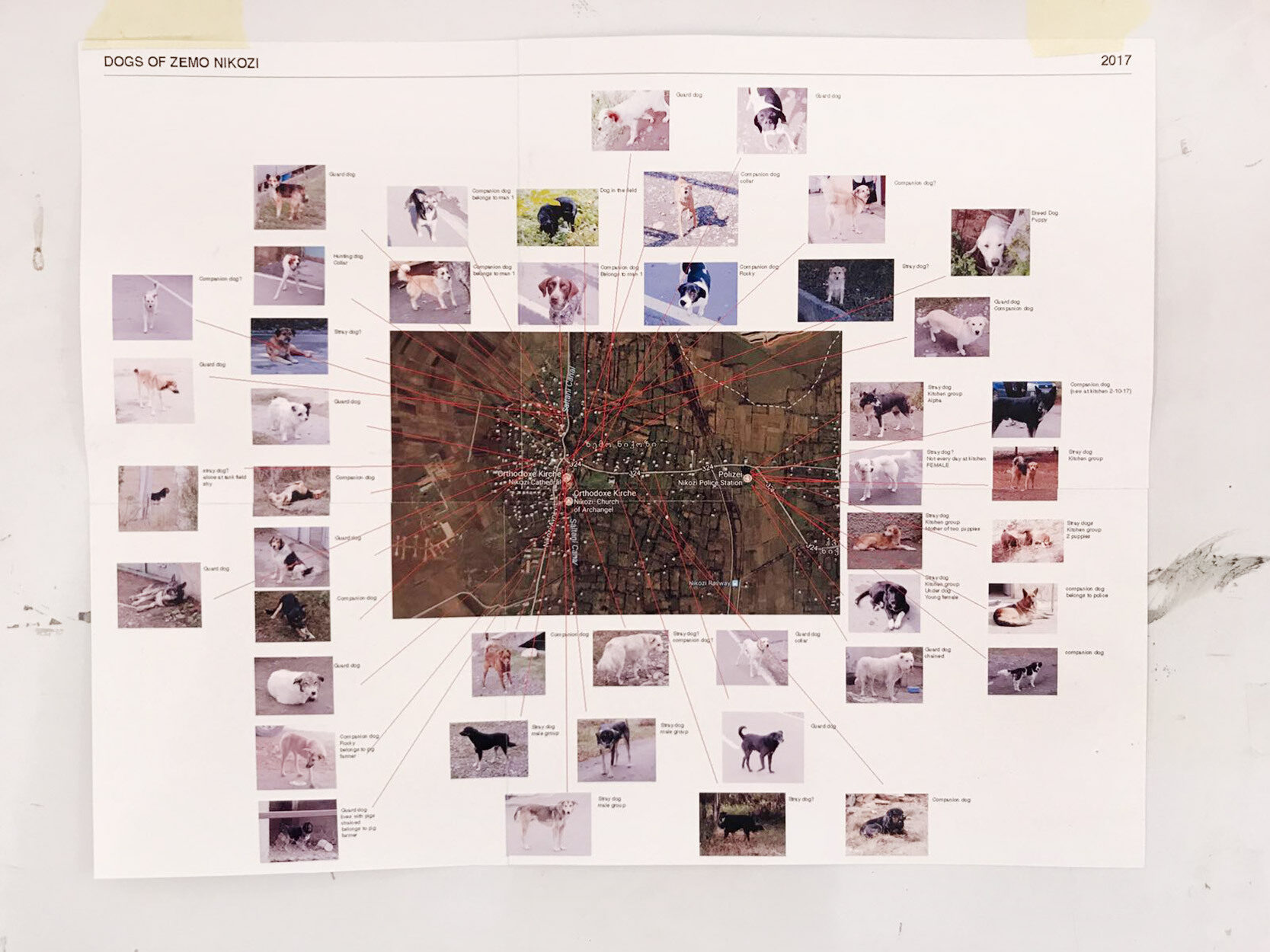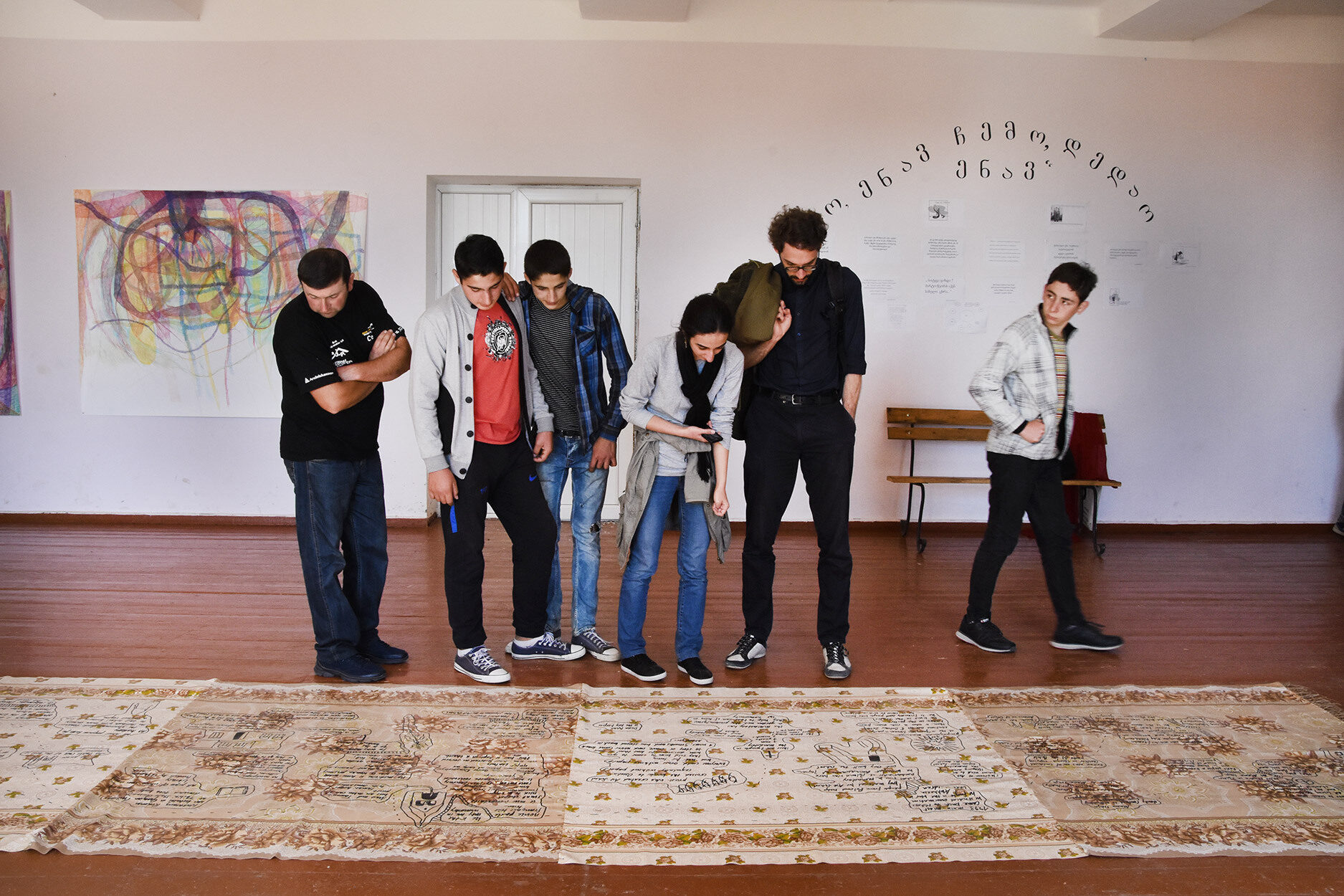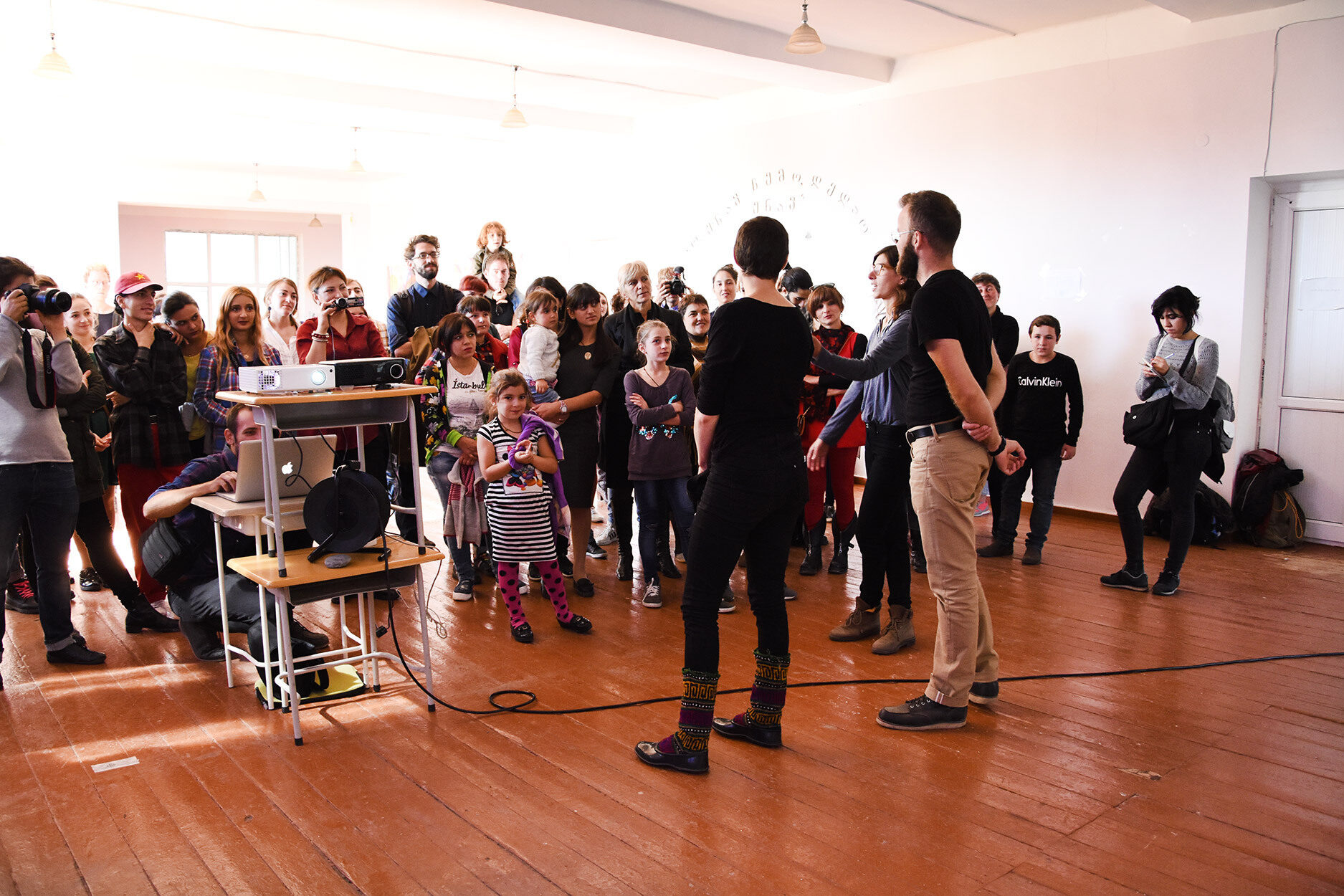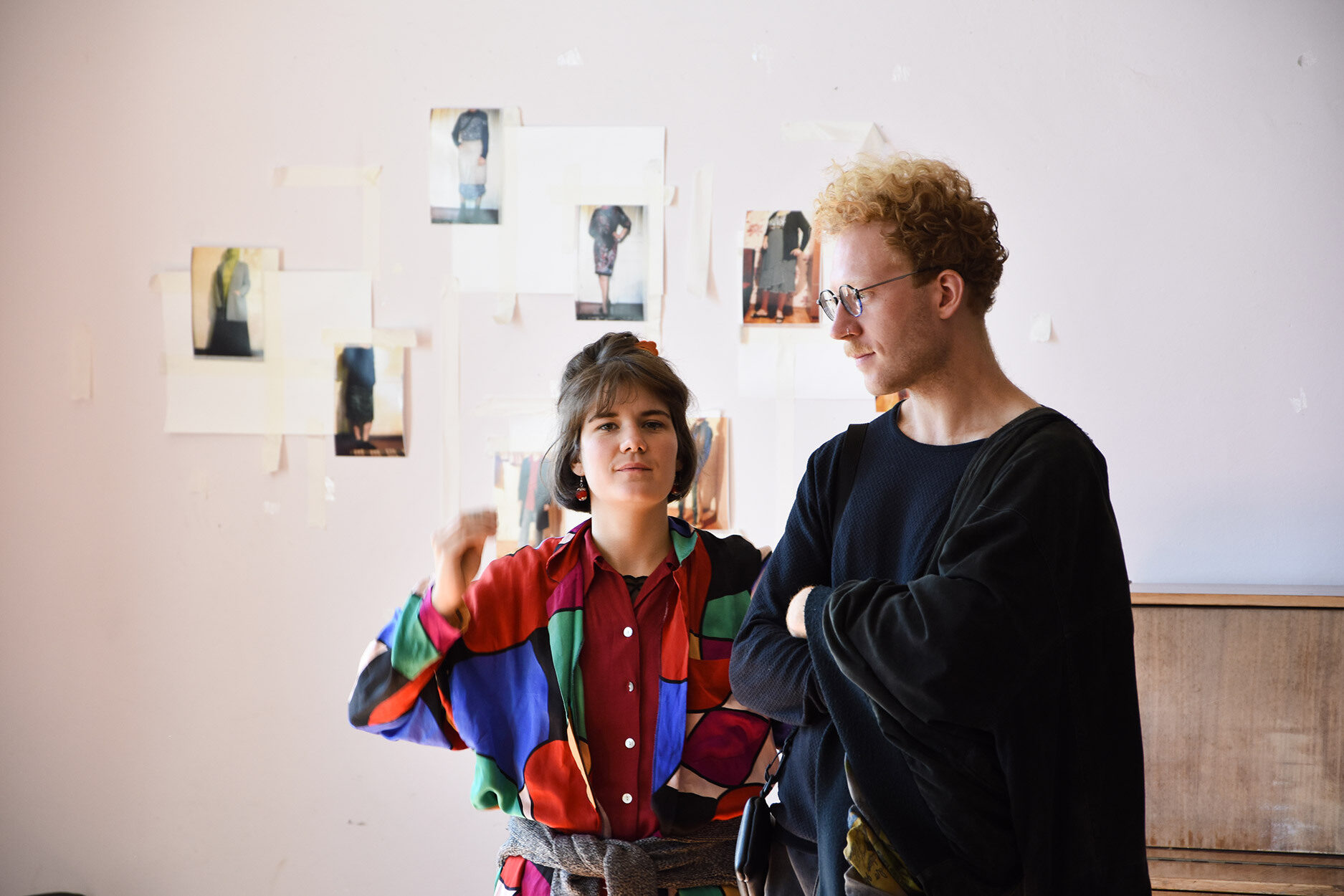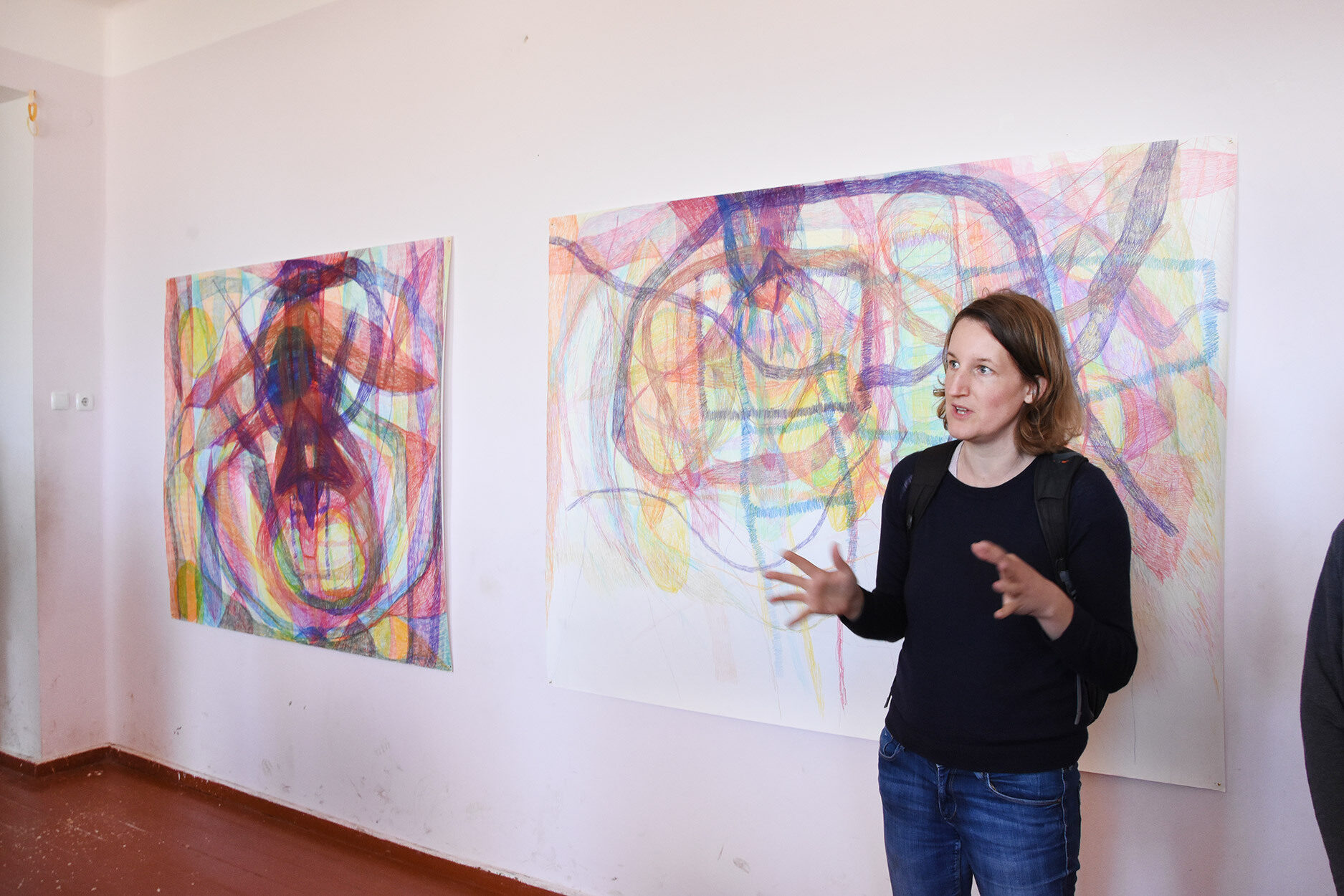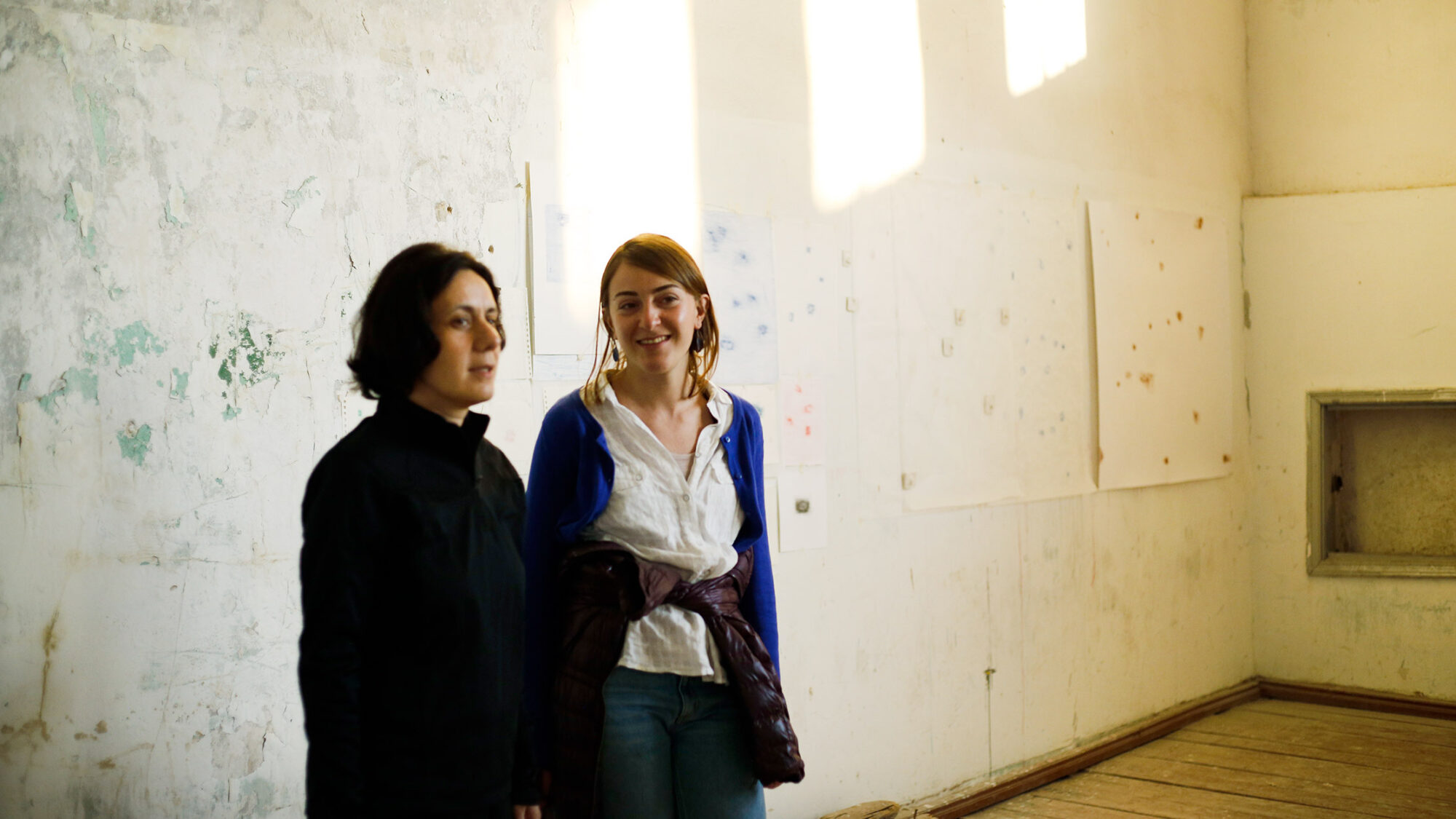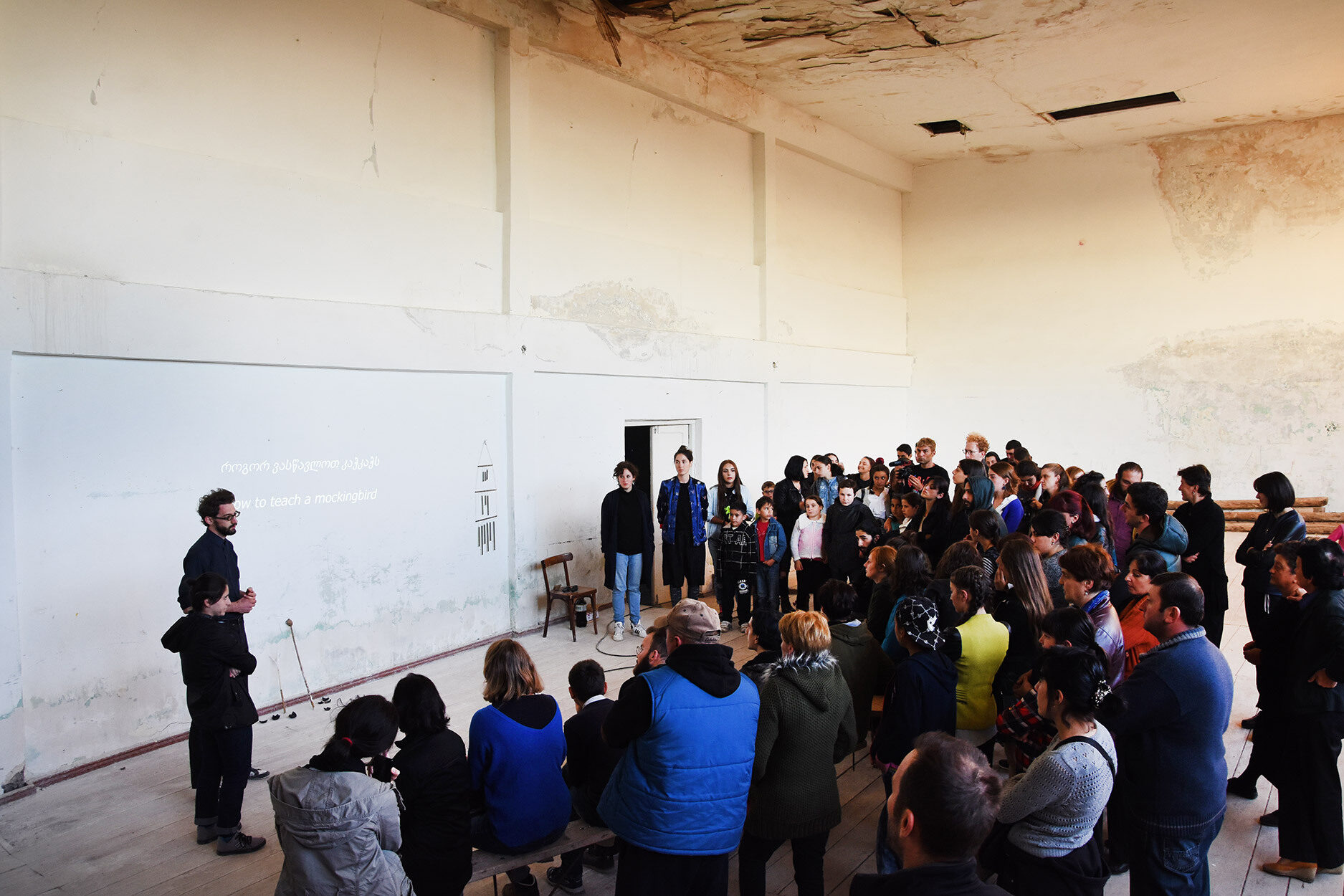off/line
off/line was created in 2016 from the project series Art Camp and is the title of an annual joint residency of artists from Western Europe and Georgia in Zemo Nikozi, a village directly on the demarcation line/ABL to South Ossetia¹. The subtitle of the project is: What can art do in Zemo Nikozi?
The long-lasting tensions in the Shida Kartli region led to war in 2008 and to the current de facto separation of South Ossetia from Georgia. Zemo Nikozi lies in sight of Tskinvali, the biggest city in South Ossetia, and was hit particularly hard by the war. Today things have quietened down in the village, but the demarcation line is still secured by the Georgian military police and the entire region is stigmatized because of its proximity to the "fence". This has an impact on everyday life. For example, the residents cannot receive bank loans and live in a relatively isolated situation.
During their work stays in Zemo Nikozi, the artists lived with various families in the village. In contact with their hosts and in exchange with each other, they explored the question of what art can do in the specific situation between gradual post-war rehabilitation and stagnant conflict. The artists were free to pursue their interests and methods and to find their own ways of reacting to the encounters, themes and needs that arise in Zemo Nikozi. What perspectives could be found in the place and for the place? Which stories and everyday phenomena manifested themselves in village life and which remained intangible? How could pictures and shared experiences be created that take into account the different backgrounds of Swiss and Georgian artists and the village population?
Daily discussions took place among the artists about the work processes and experiences; in a final public presentation, they shared their work with the villagers.
The goals of off/line concern on the one hand the place and the local population, where the project not only brings a source of income (through accommodation) but also interesting questions and new impulses through exchange and encounters with foreigners. On the other hand, the aims of the project concern the debates between the invited artists, their site-specific work and a reflection on the structure of the encounters and collaborations that arise in the process this work.
off/line 2019
In October 2019, the exchange programme off/line took place for the 5th time. Twenty artists from Western Europe and Georgia travelled to the Georgian village of Zemo Nikozi, where they were warmly received by the villagers. This year, the idea was to reflect the history of this exchange project within the framework of this current edition. The curators, Marcel Bleuler and Lali Pertenava, invited the artists to think about the following questions: what has been the effect of art on Zemo Nikozi? What do the villagers and hosts wish from the artists? How should the project be pursued?
Many of the participants formed small groups and worked together on the topics with the villagers. Individual art projects were also carried out. Georgian and West European artists worked in close collaboration in an inspiring and appreciative atmosphere.
One group of artists (Cana Bilir-Meier, Veronika Burger, Paula Ďurinová, Nutsa Esebua, Anna Fatyanova, Tina Henkel, Mona Hermann, Tamar Nadiradze, Ninutsa Shatberashvili) devoted itself to the role of women in the village and organised an evening ‘for women only.’ They cooked for the guests from the village, who enjoyed the treat and could relax from their household duties. The atmosphere of trust led to deep and very personal conversations, the content of which remained within the group. Some of the artists (Michel Eisele, Giorgi Geladze, Kniko Grdzelishvili) developed ideas for the children from the village. They set up a temporary workshop in the former community hall, where they met every day with the children and elaborated small projects together with them. They talked, drew, painted, and made music without the pressure of results.
One group (Nutsa Esebua, Manuela Luterbacher, Maëlle Torné) decided to ask the villagers about their wishes. They contributed readily to the fulfilment of some of the wishes. In this way the decoration of a house could be worked out and realised with the owners. This led to a fascinating discussion about what is art and what is beautiful. While the artists wanted to paint a decoration in a contemporary aesthetic, the owners of the house preferred a more figurative decoration, like a pond with swans. It became clear that the important thing was neither the subject-matter, nor the style, but the fact of decorating together.
Several art projects reflected on the everyday life in the village. An exciting example was the work of Paula Ďurinová. The artist suggested that the villagers film the most important and valuable objects in their households. The villagers became filmmakers and collaborators in the artistic work, and the film a self-portrait in which they could recognise themselves. The voice of the villagers was given a visible ‘value’. Natia Benashvili also started from contributions by the villagers. She collected utterances in the village and painted these texts on the walls of an abandoned signal tower along the railway. Sopho Kobidze designed a site-specific installation in a garden in which she thematized the importance of the soil and earth as the basis for nutrition in the village. Nutsa Esebua devoted her work to the role of the garden, drawing a map of apple orchards whose access had been blocked by the war. Michel Eisele immortalized his efforts with the village and its language on the wooden boards of his host family’s old wine press. Maëlle Torné and Jordis Fellmann livened up an abandoned industrial lot on the outskirts of the village, setting their works in the context of the landscape.
The atmosphere in the artists’ group was an important feature of the work in Zemo Nikozi. That is why the artist Cana Bilir-Meier turned her attention to the group dynamics. For this, she drew on tools for team-building in the form of group exercises with the artists. This brought the group together and supported the individuals in coping with the village, even in the absence of a common language. In a general manner, language and above all the role of the interpreters were decisive. The challenges for the participants who spoke Georgian or Russian were especially great. The artist Veronika Burger based her video work on this.
Many of the projects were of a participatory and socially committed nature. The creative collaboration intensified an exchange between the cultures in which all could learn from each other. One often heard villagers say how ‘powerless’ individuals were in the face of ‘big politics’: ‘What can we do? We don’t decide anything’. The collaboration on the artworks offered the villagers a context in which they could experience self-confidence and their own worth again.
Although the inhabitants of Nikozi talked a lot about the war, they preferred remembering the times before it, when there were no demarcation line and they could travel about freely. Most of the villagers would even travel on business to Russia, where they could sell their Georgian products, mainly fruit and vegetables. Many had family on the other side of today's demarcation line and in Russia.
‘We travelled a lot and often had visits from Russian friends and relatives. Nowadays, not even the birds fly there and back,’ said the grandmother of one of the host families. In each of the families, one could sense the longing for exchange and free movement. That’s why the off/line project is no less inspiring and important for the villagers.
Place and Year
Zemo Nikozi, 2019
Participating Artists
Sofo Kobidze, Nutsa Esebua, Natia Benashvili, Magnus Lorenz, Giorgi Geladze, Ninutsa Shatberashvili, Giorgi Vardiashvili, Paula Ďurinová, Anna Fatyanova, Manuela Luterbacher, Maelle Torné, Jordis Fellmann, Cana Bilir-Meier, Michel Eisele, Veronika Burger, Tina Henkel, Mona Hermann, Tamar Nadiradze, Kniko Grdzelishvili, Evan Ruetsch
Curators and Local Coordination
Marcel Bleuler (artasfoundation)
Lali Pertenava, Tiflis
Interpreters
Marta Todua
Magda Mamaladze
off/line 2018
In 2018, off/line was already in its fourth year. Twenty-four artists from Western Europe and Georgia took part in this exchange project and travelled to the village of Zemo Nikozi on the demarcation line from the war between Georgia and Russia about South Ossetia¹. The residents were welcoming and curious towards the arriving artists. They organized ‘supras’ around the campfire, engaged in sometimes surprising collaborations and showed their skills at the final event, which once again attracted visitors from the entire region with its Open Stage. The invited artists also presented their works on this final day: such as, newly-made video films, equipment built together with local young people for the local bodybuilding studio, a new clothing collection made from work clothes, and also the ‘largest apple pie in Georgia’ produced – and afterwards eaten – with the participation of the entire village.
However, the growing familiarity with Zemo Nikozi also made prevailing tensions more visible. For the first time, the host families, each of which accommodated two artists and who were paid for their work were selected through the drawing of lots from among all those interested. The fair and transparent procedure in itself caused a stir in the village, and self-interests and ideas of justice were clearly formulated for the first time. artasfoundation’s claim to conflict sensitivity was put to the test. In the course of the project, however, it became apparent that discussion also leads to activation. For the first time the village community was interested in the budget of off/line, the origin of the money and the goals pursued by artasfoundation. The friendly restraint gave way to a debate that took relationships to a new level. Since the meaningfulness of the artists’ stay in the village was never called into question, artasfoundation decided to continue in the following year.
Place and Year
Zemo Nikozi, 2018
Participating Artists
Aleko Avazashvili, Baptiste El Baz, Nathalie Brechbühl, Paula Ďurinová, Elene Gabrichidze, Mariam Giunashvili, Eka Ketsbaia, Tamar Khmiadashvili, Ilia Kobeshavidze, Nathalie Koger, Manuela Luterbacher, Stephanie Müller & Klaus Dietl, Johanna Padge, Solomon Razmadze, Evan Ruetsch, Tsira Sanaia, Lena Lieselotte Schuster, Levan Shvelidze, Jelko Terziev, Natuka Vatsadze, Nurith Wagner-Strauss, Nino Zirakishvili.
Curators and Local Coordination
Marcel Bleuler (for artasfoundation)
Lali Pertenava, Tbilisi
Translators
Tiko Davitashvili
Salome Todua
Financial Contribution
Max Kohler Foundation
off/line 2017
In late September 2017, 12 artists from Georgia and 12 from Switzerland, Austria and Germany travelled to Zemo Nikozi for a two-week exchange and work stay. A lot had changed in the village since the previous year: the main street had been newly renovated and equipped with lighting, and the checkpoint moved to the edge of the village. The villagers, like the omnipresent police officers, were very excited about the guests, and well experienced in accommodating the group (all artists lived in pairs with a host family).
As in the previous year, the group met daily in the workshop room of the former community centre, which also houses the police headquarters and the Women’s Association, one of the two informal partner organisations that occasionally support the artists with great openness. With the help of translators, the artists pursued their own work interests from day one and looked for starting points to deal with the place and its inhabitants. Due either to the artists selected or the growing openness of the residents of Nikozi, they became increasingly involved in the artistic projects. On the closing day, which was marked by presentations, exhibitions and a celebration, they appeared at the Art, Craft and Everyday Objects Museum (organized by Johanna Padge, Stefanie Rittler and Lali Pertenava), performed at the Open Stage (organised by Nino Khurashvili and Jürgen Rendl), ventured to pose in the photo sets (by Nina Willimann, Nora Longatti, Inga Shalvashvili) and contributed to the buffet with local specialties (organised by Jennifer Mira Ackermann and Martha Todua). The stay proved to be productive both from an artistic point of view and in terms of mutual exchange within the triangle of artists from Eastern and Western Europe and inhabitants of Nikozi, and will definitely be resumed.
Place and Year
Zemo Nikozi, 2017
Participating Artists
Anna Witt, Benjamin Egger, Esther Kempf, Fanni Futterknecht, Gocha Jgenti, Inga Shalvashvili, Jennifer Mira Ackermann, Johanna Padge, Jürgen Rendl, Kamen Stoyanov, Katharina Swoboda, Lado Lomitashvili, Mariam Pesvianidze, Mariam Gabrichidze, Mrvarisa Joyce, Nina Willimann, Nino Khurashvili, Nora Longatti, Nurith Wagner-Strauss, Stefanie Rittler, Tatja Tvaladze, Tiko Qsovreli, Toma Glurjidze, Vato Jorkoshvili
Curators and Local Coordination
Marcel Bleuler (artasfoundation)
Lali Pertenava, Tbilisi
Translators
Marta Todua
Elene Maisuradze
Financial Contribution
Austrian Embassy, Tbilisi
off/line 2016
off/line 2016 took place with 11 artists from Switzerland and Germany and with an equally large group of artists from Georgia. Their work processes pointed in very different directions. Many of them remained explicitly open about their outcome. The aim of artasfoundation was to promote encounters and artistic exchange, as well as to facilitate new dynamics in village life. Most of the artists worked in collaboration and followed the individual perspectives of village residents. Daily discussions about working processes took place in a local workshop space. The end of the work phase was celebrated in the local school and the former cultural centre of the village with public presentations and a joint celebration.
Place and Year
Zemo Nikozi, 2016
Participating Artists
Linda Pfenninger, Nino Megrelishvili, Till Wittwer, Tornike Gabedava, Marc Horler, David Kukhalashvili, Benjamin Egger, Philip Michael Matesic, Levan Shvelidze, Sara Grütter, Naili Vakhania, Nuca Esebua, Deirdre O’Leary, Lea Rüegg, Mariam Aghdgomelashvili, Mari Panculaia, Olivia Jaques, Luiza Laperadze, Tamar Botchorishvili, Sabine Schlatter, Inga Shalvashvili, Nora Longatti
Curators and Local Coordination
Marcel Bleuler (artasfoundation)
Lali Pertenava, Tbilisi
Translators
Martha Todua
Elene Maisuradze
Financial Contribution
Swiss Agency for Development and Cooperation for South Caucasus (SDC)
¹artasfoundation would like to underline that its use of names and titles particularly in regards to conflict regions should not be understood as implying any form of recognition or non-recognition by the foundation or as having any other political connotation whatsoever.
